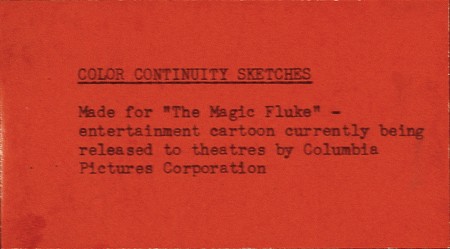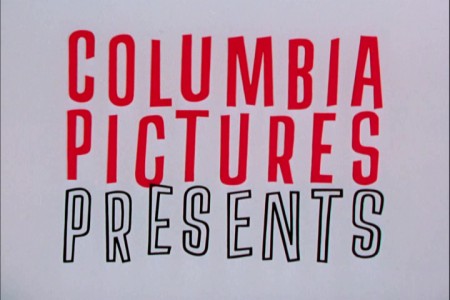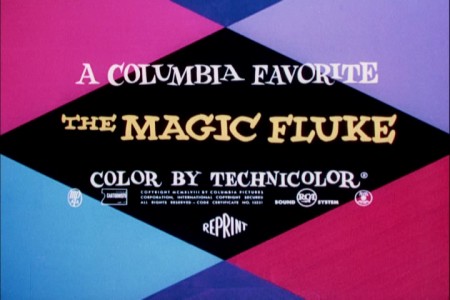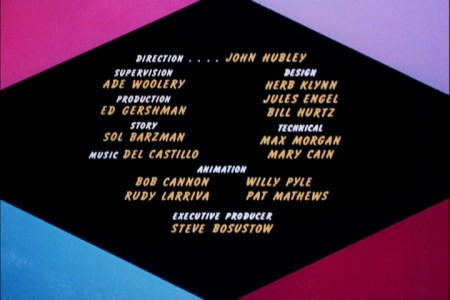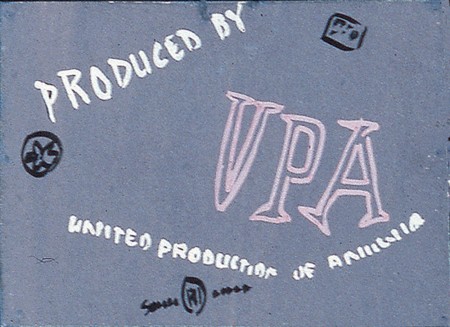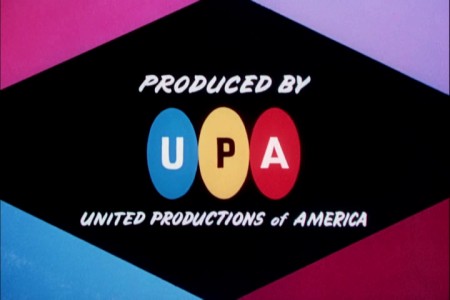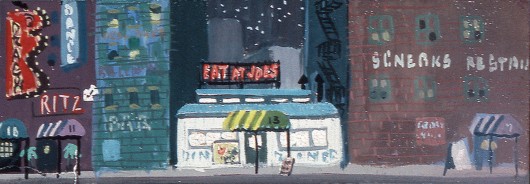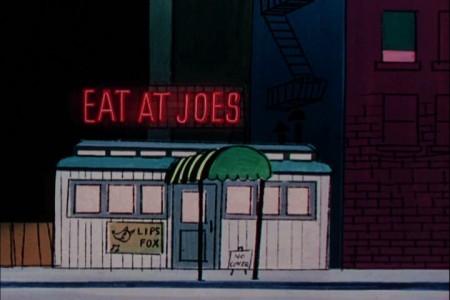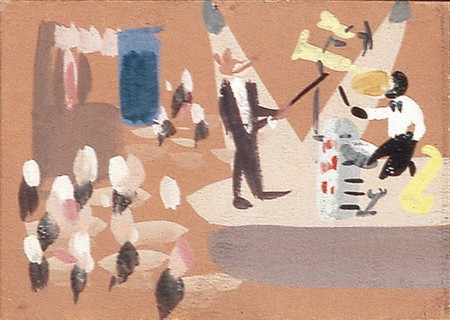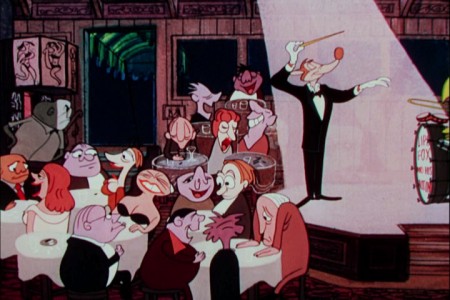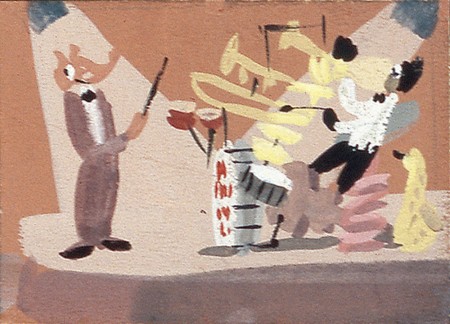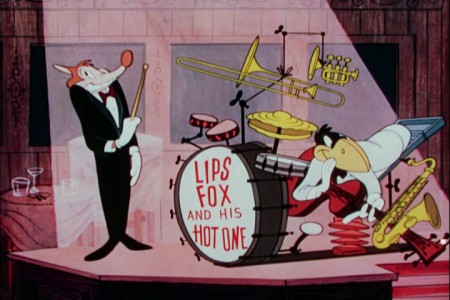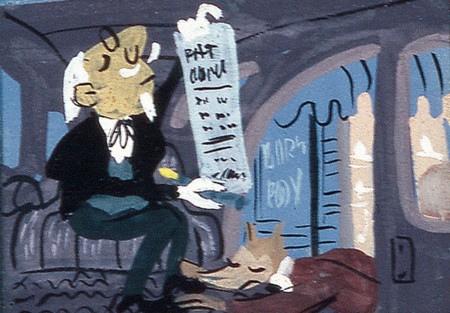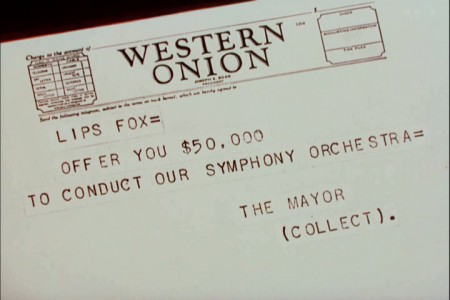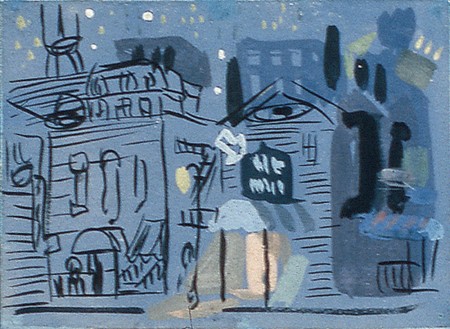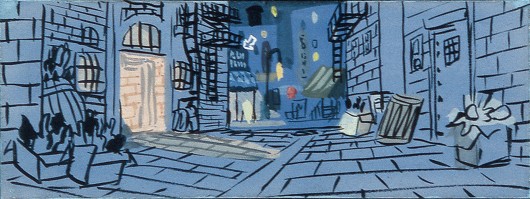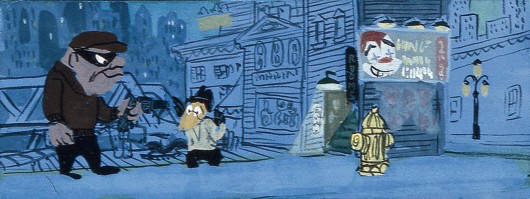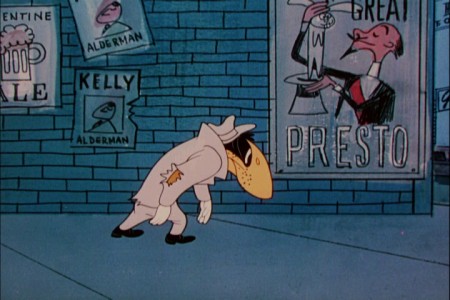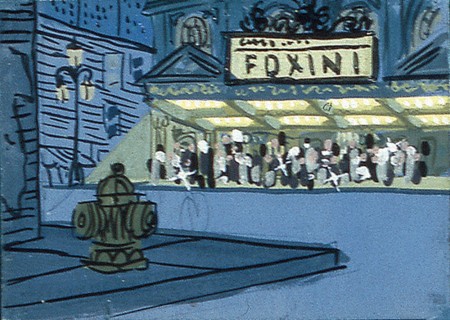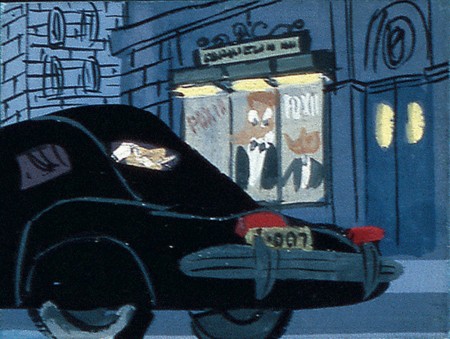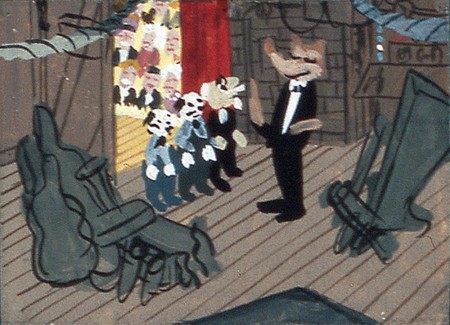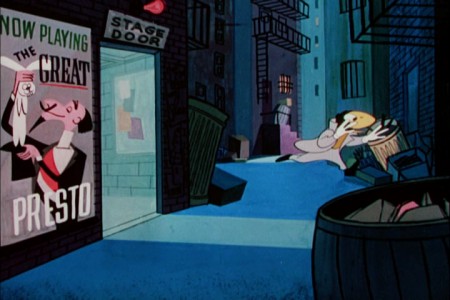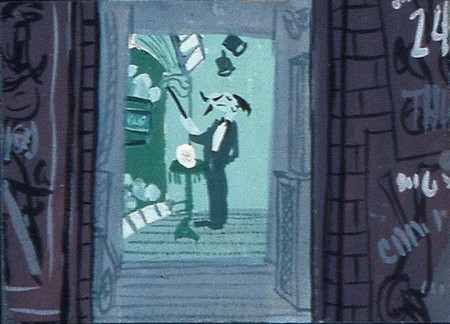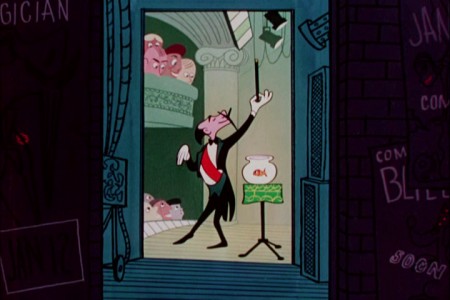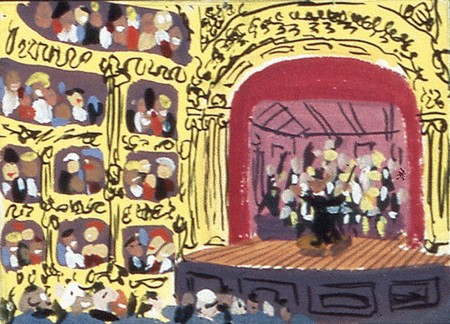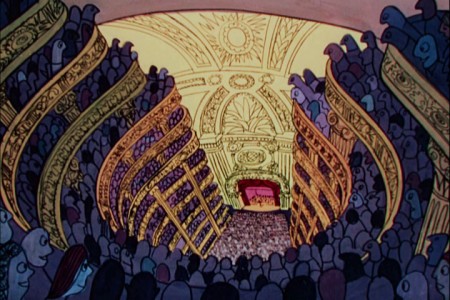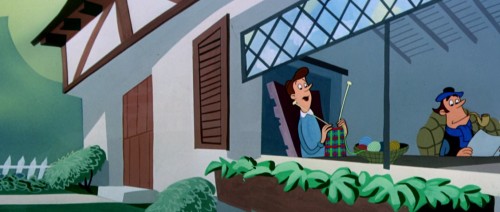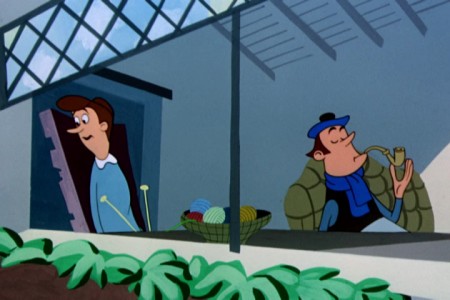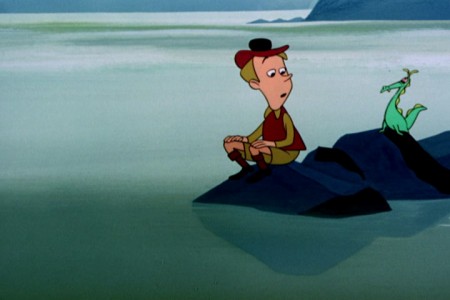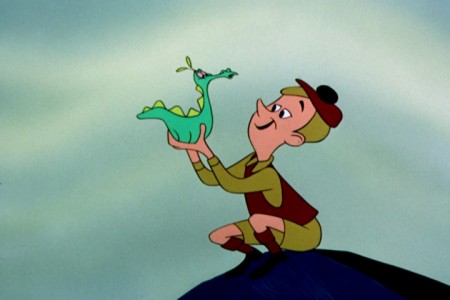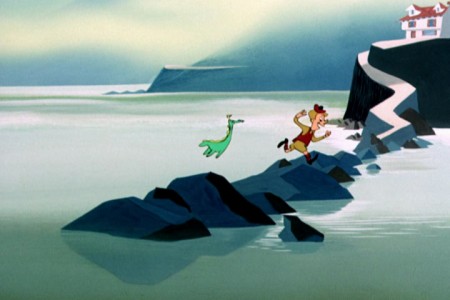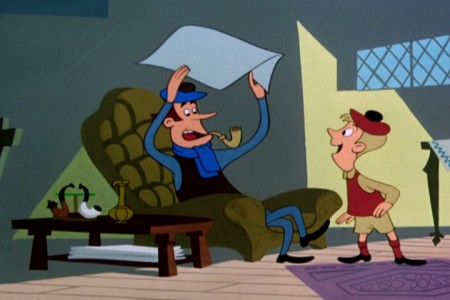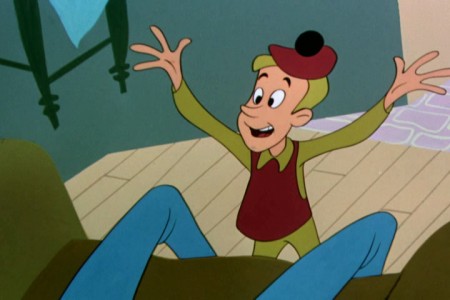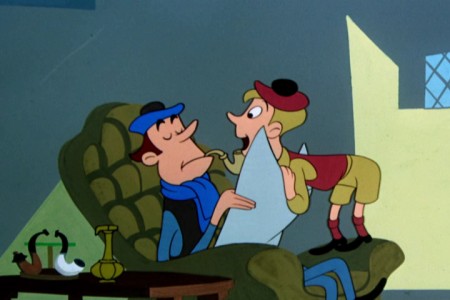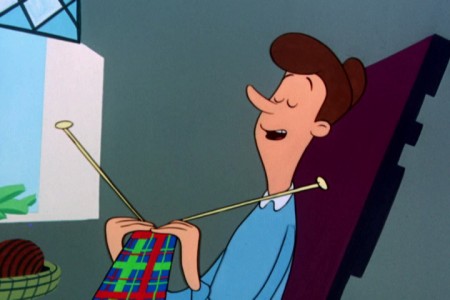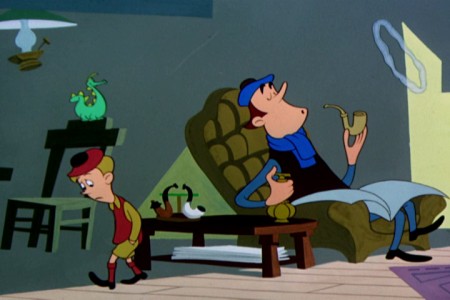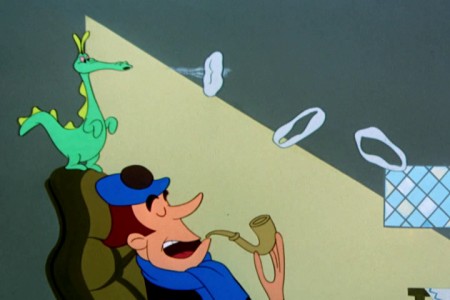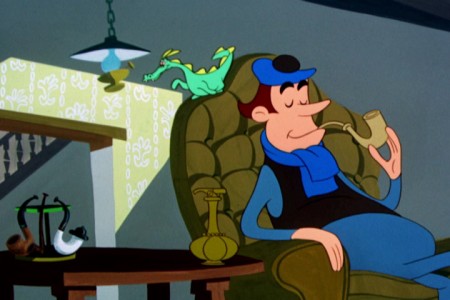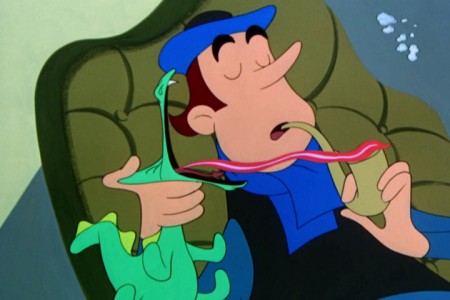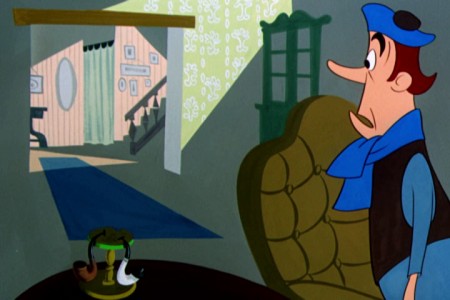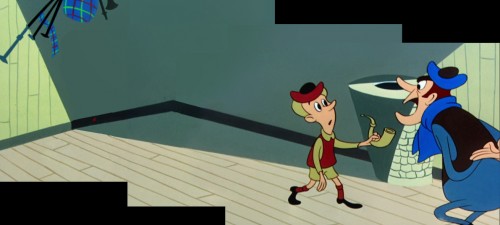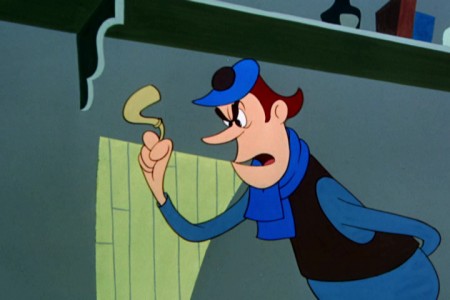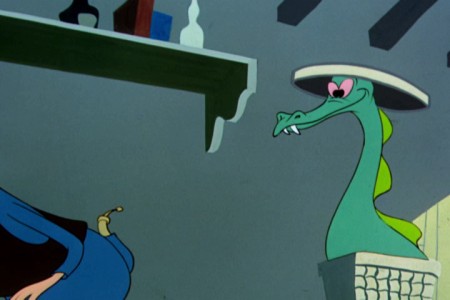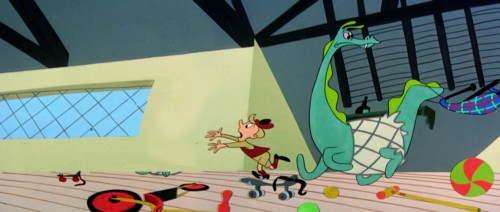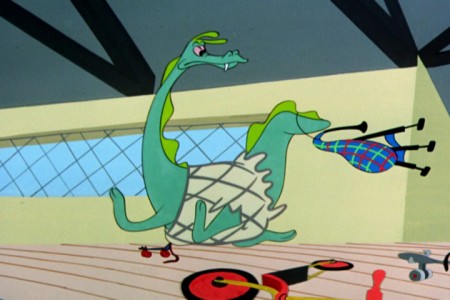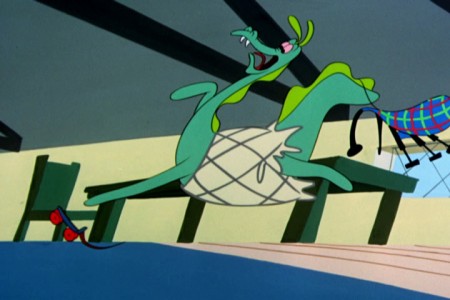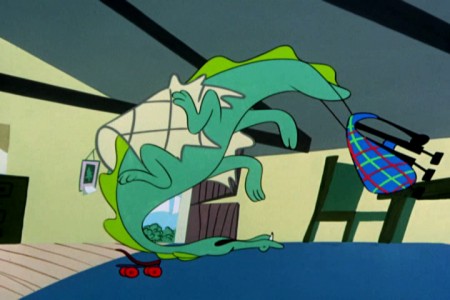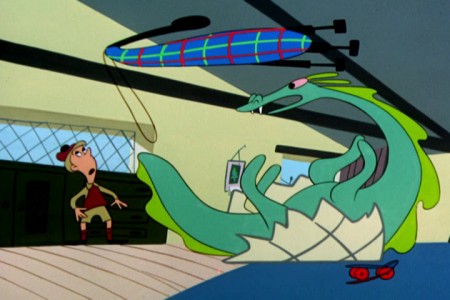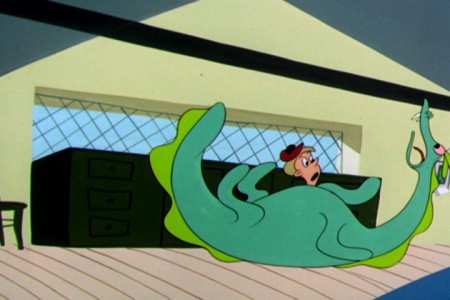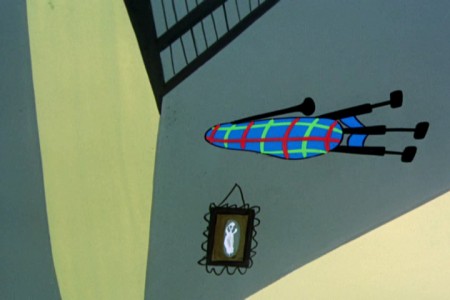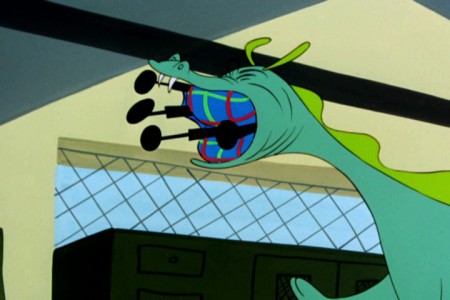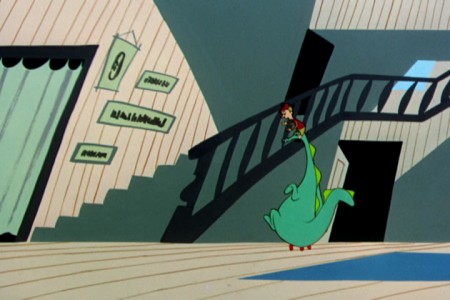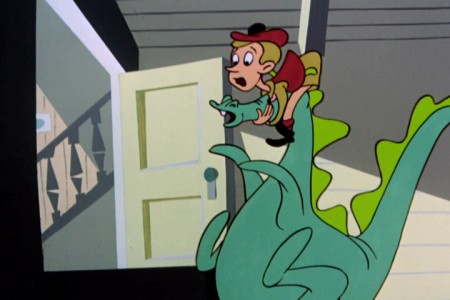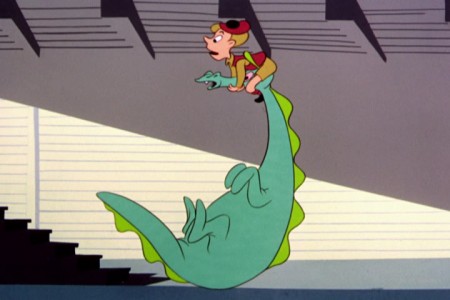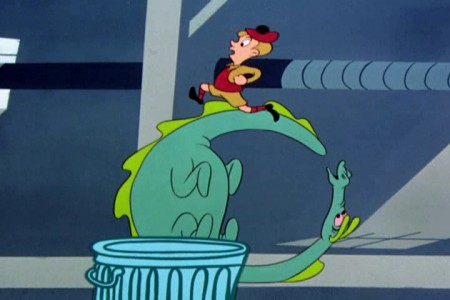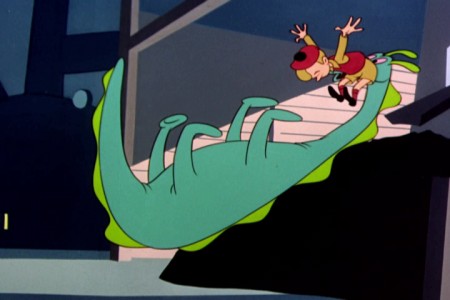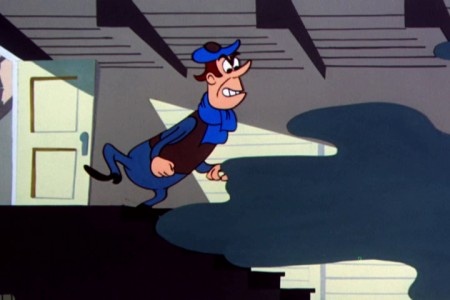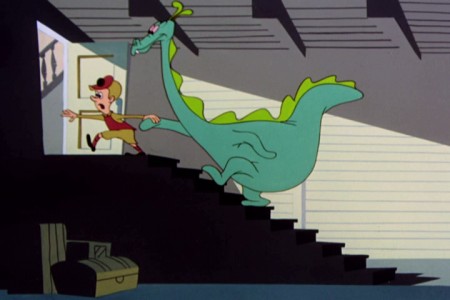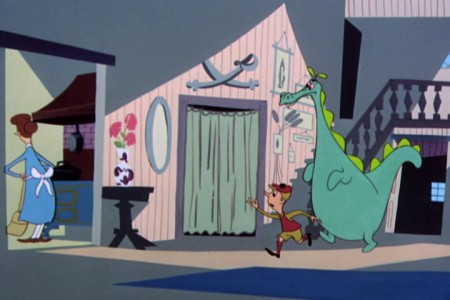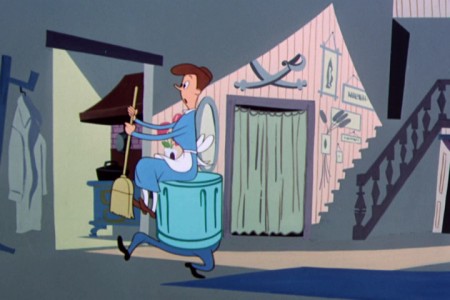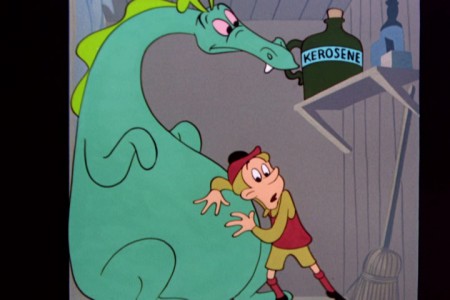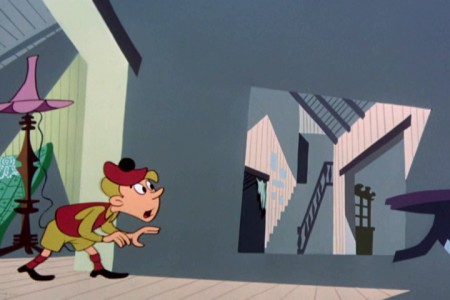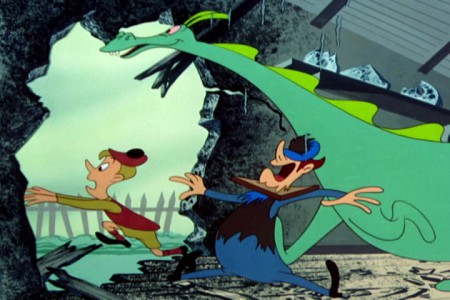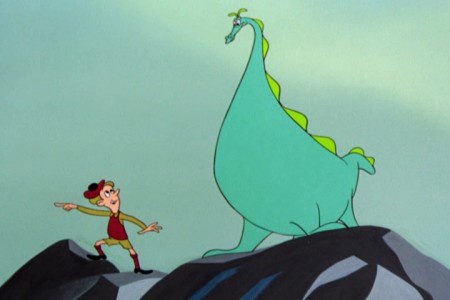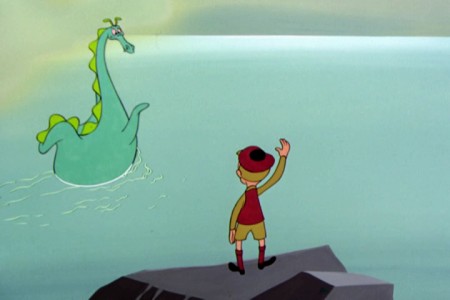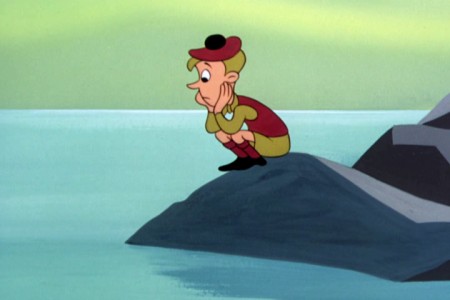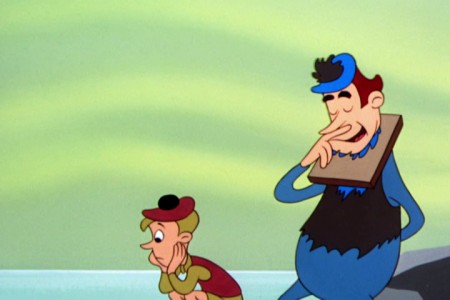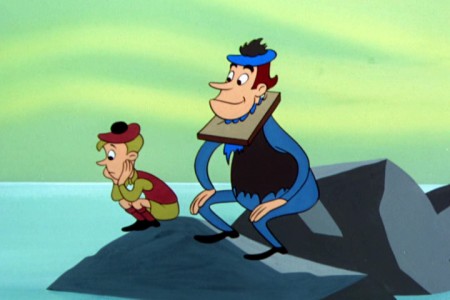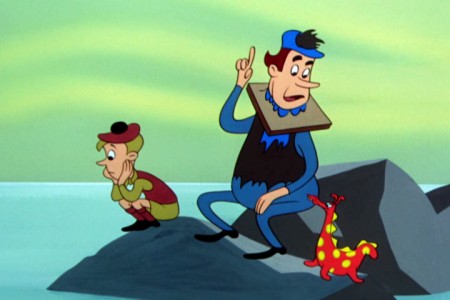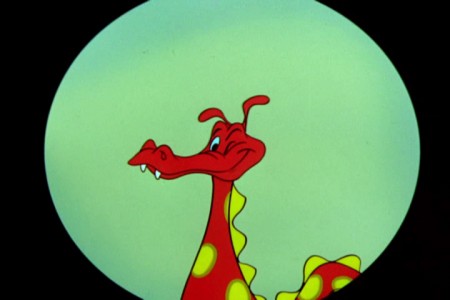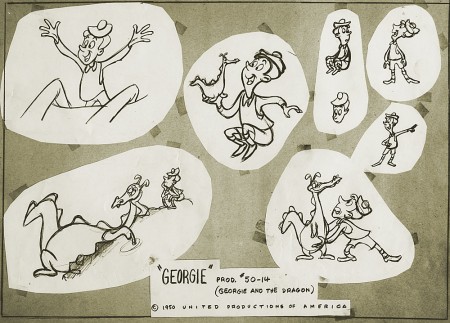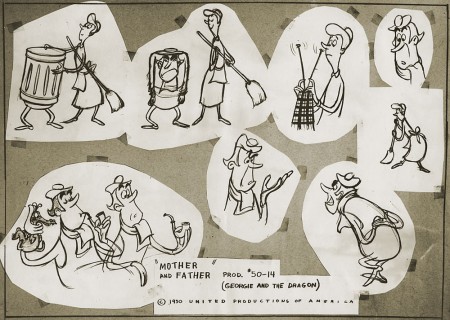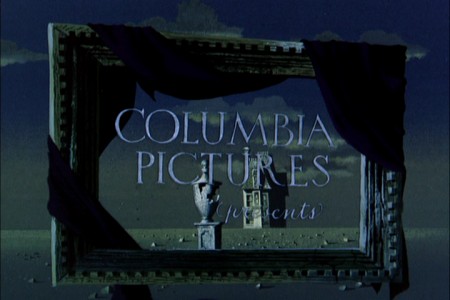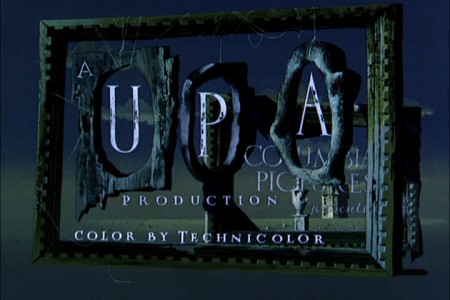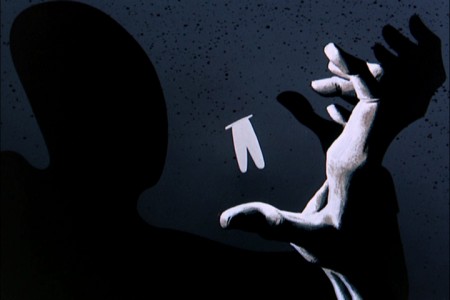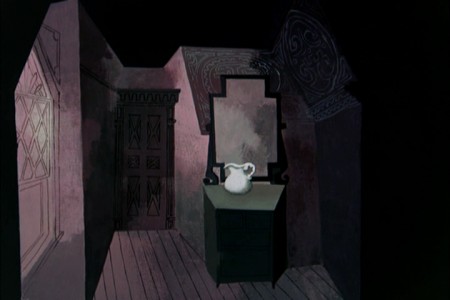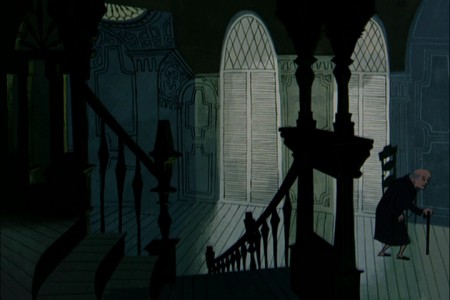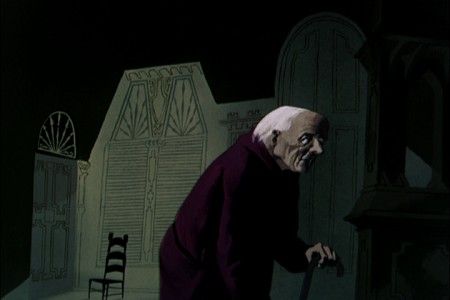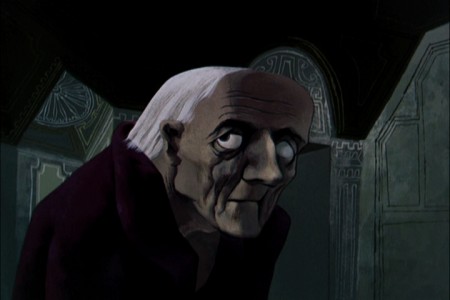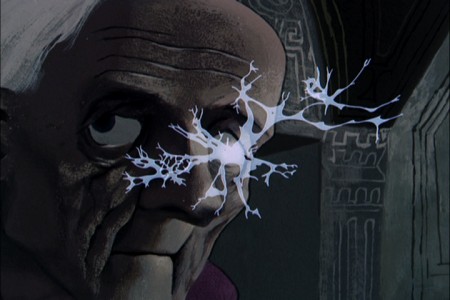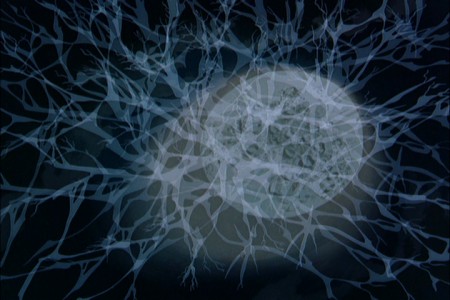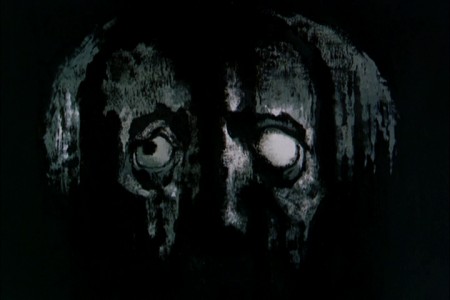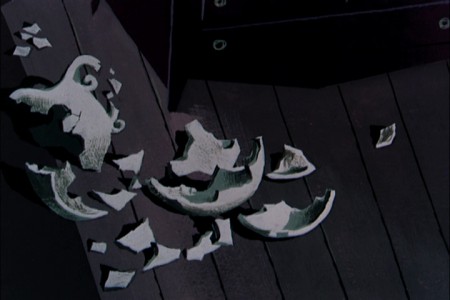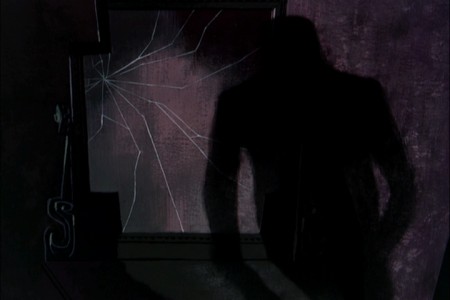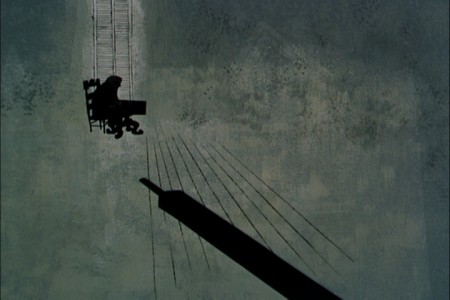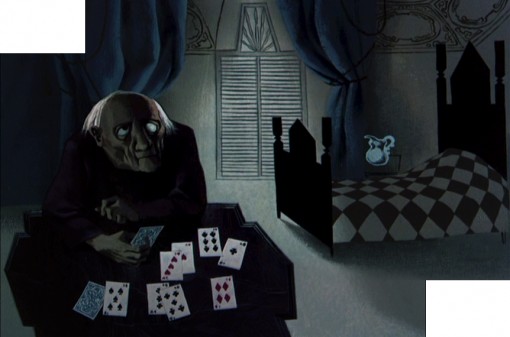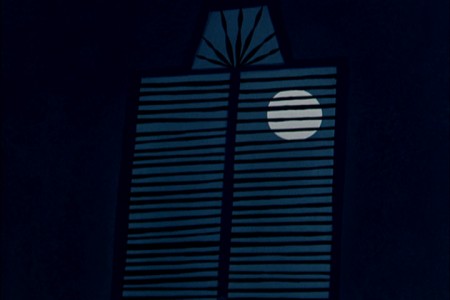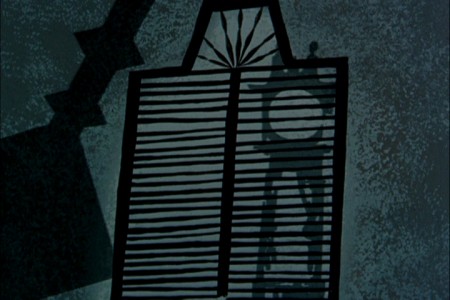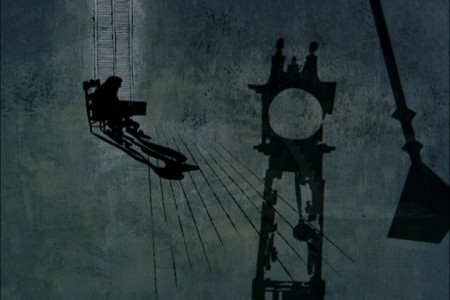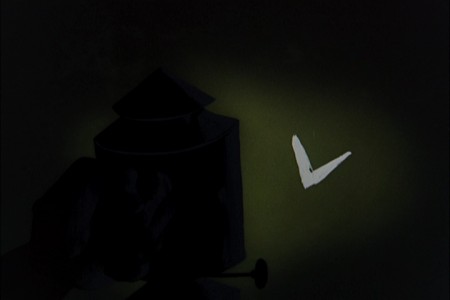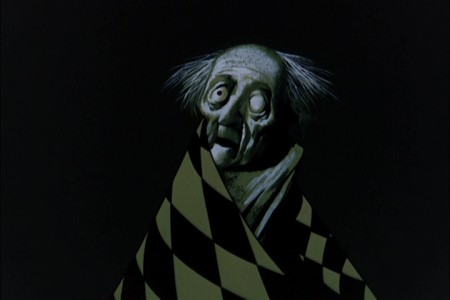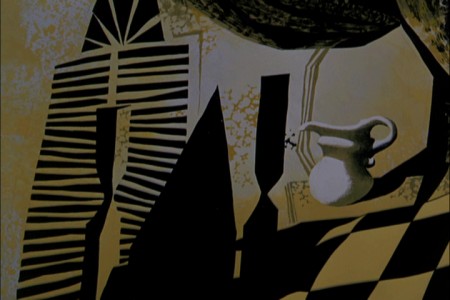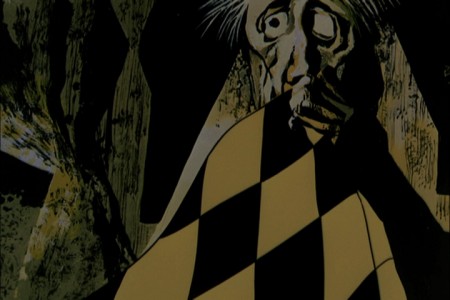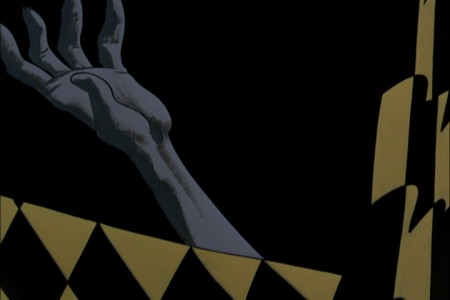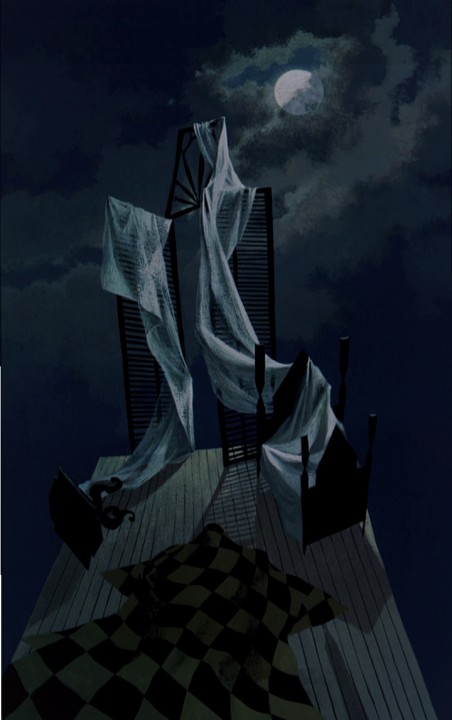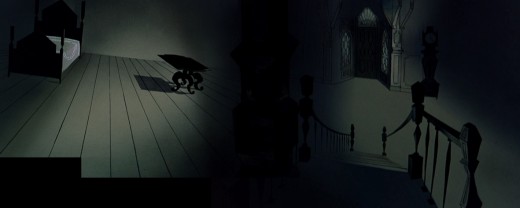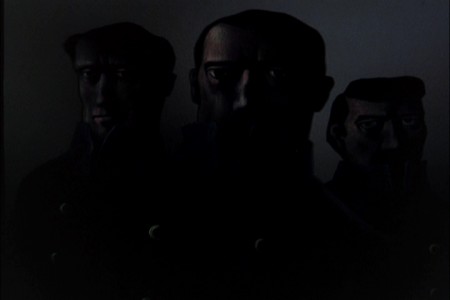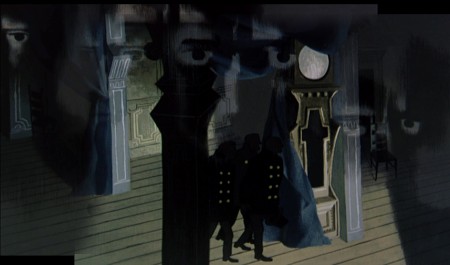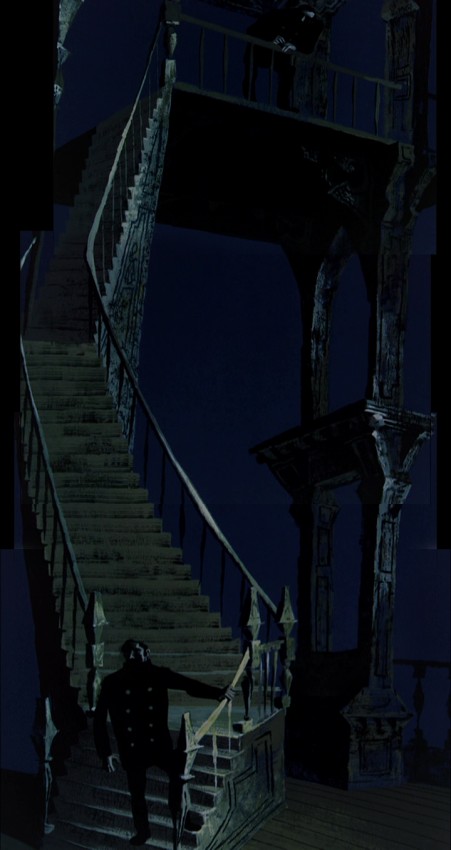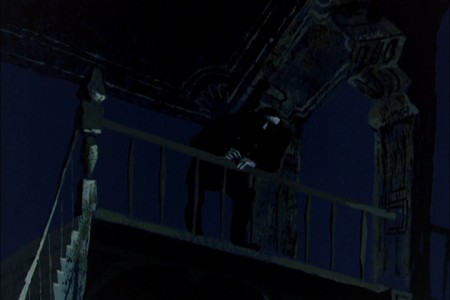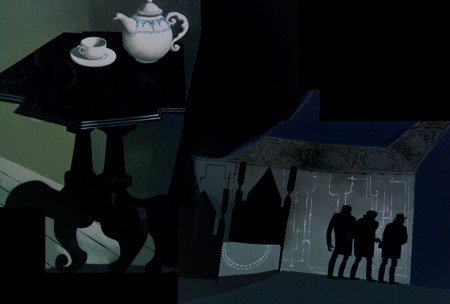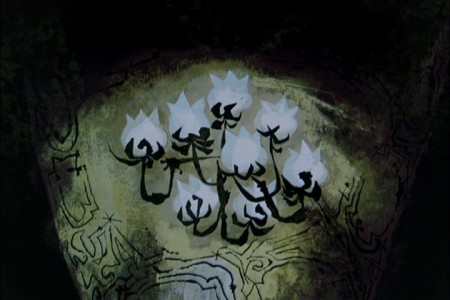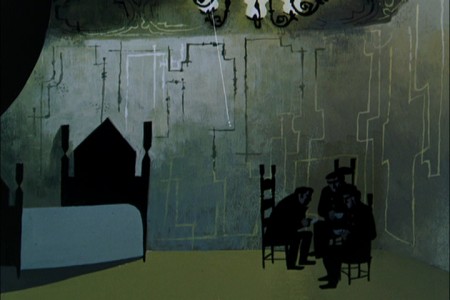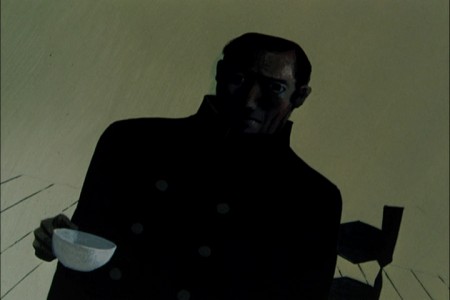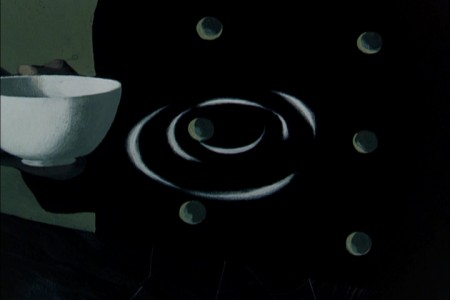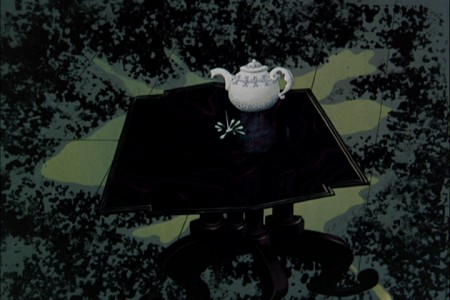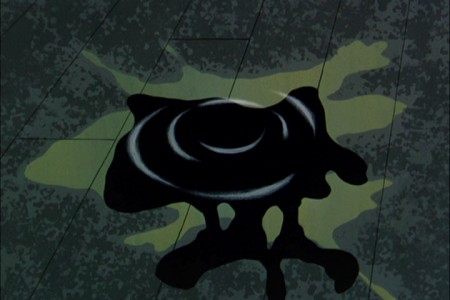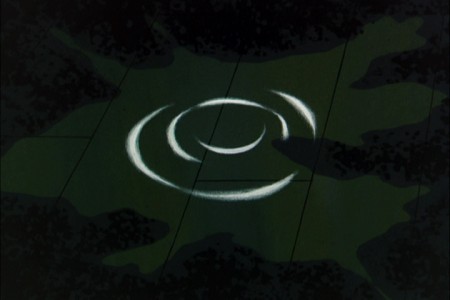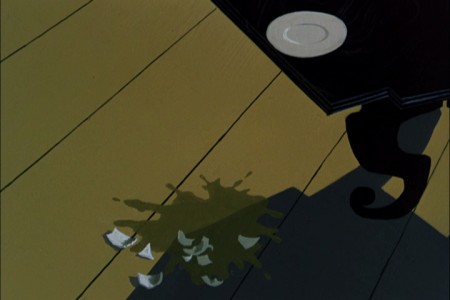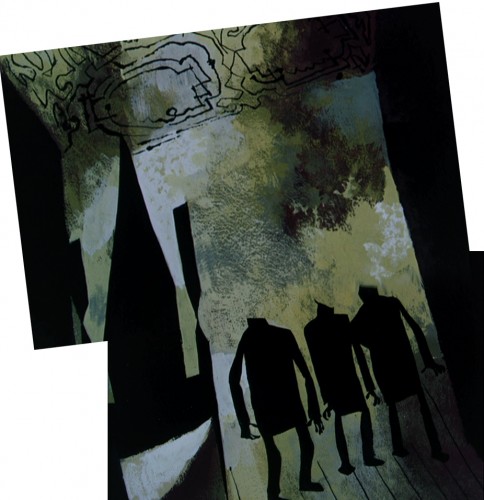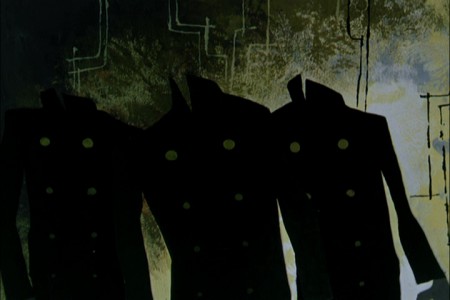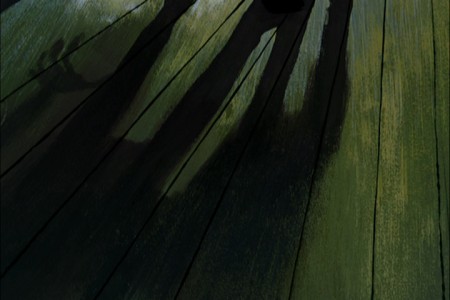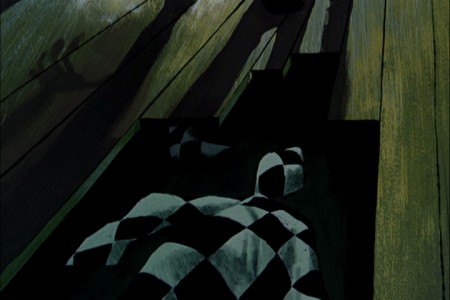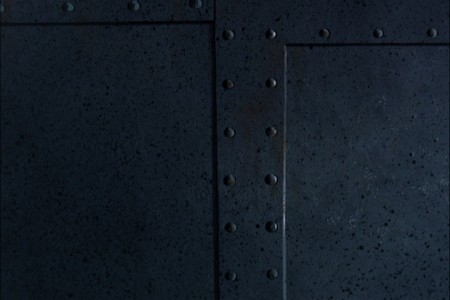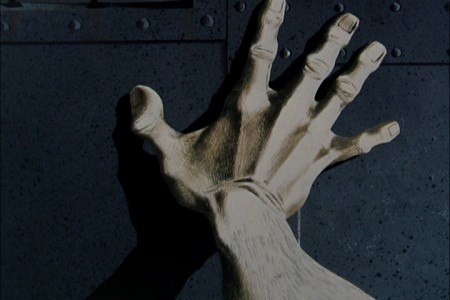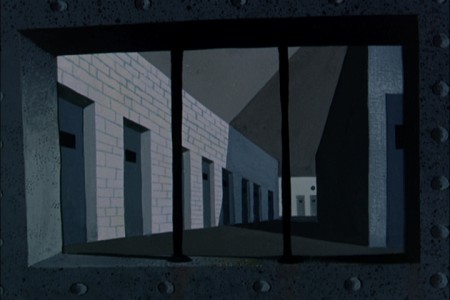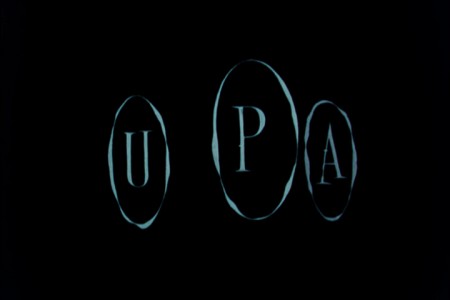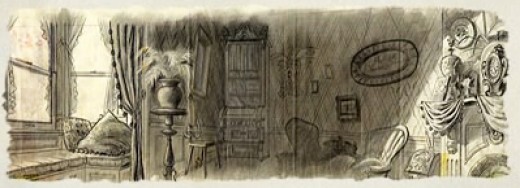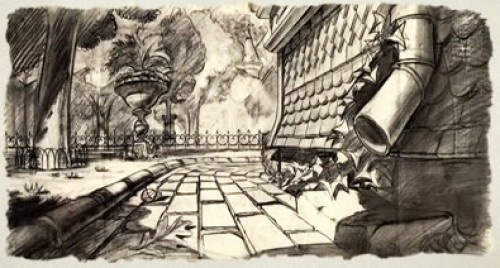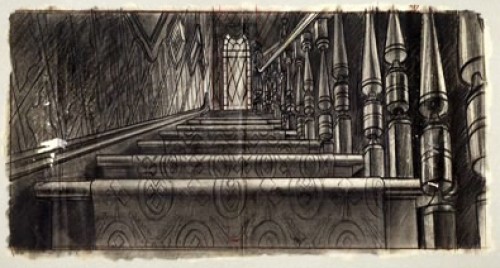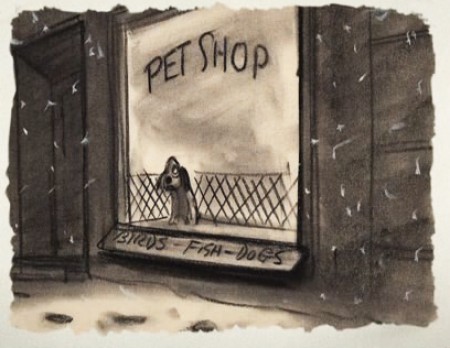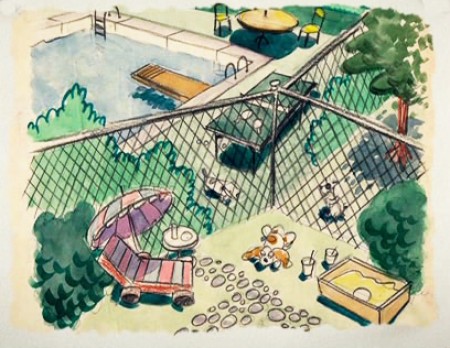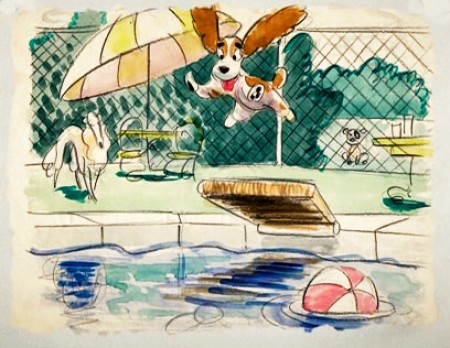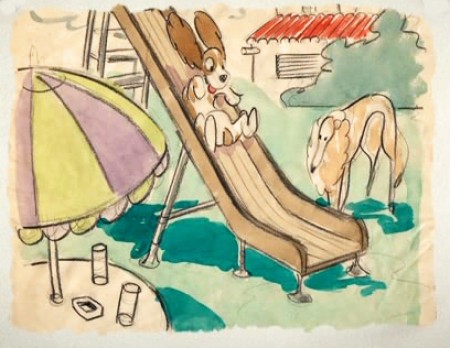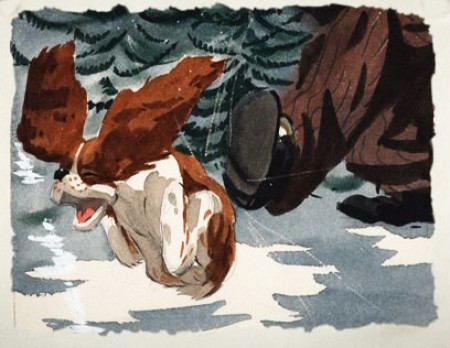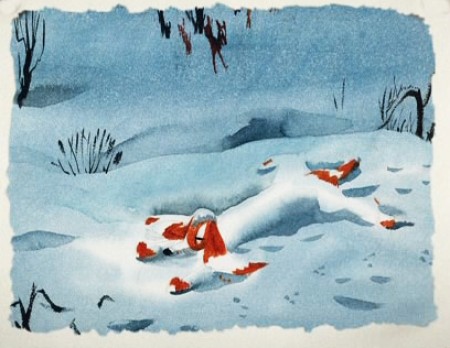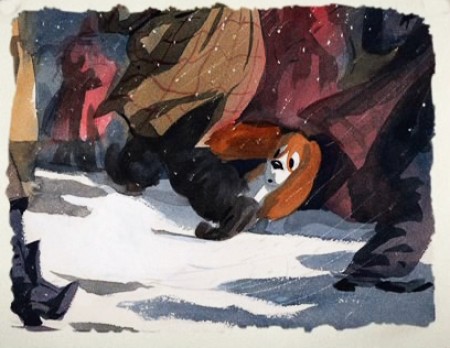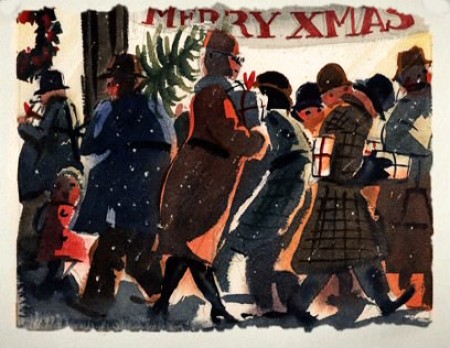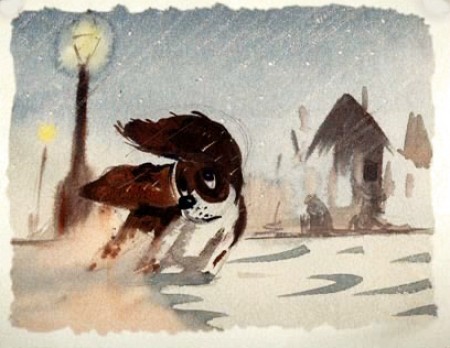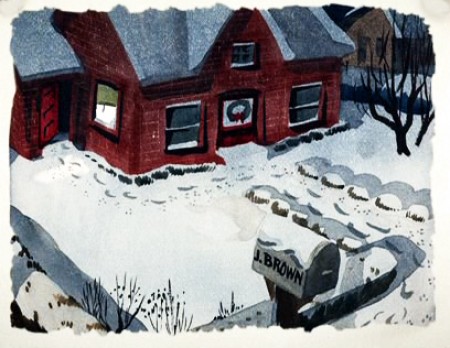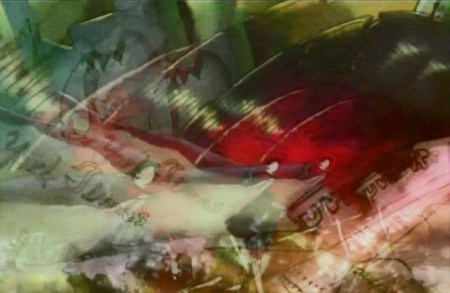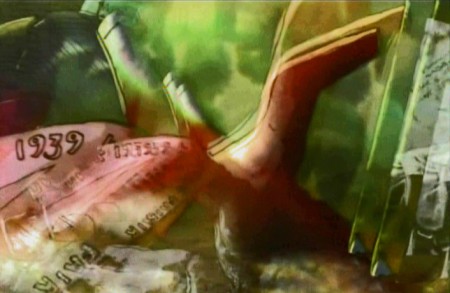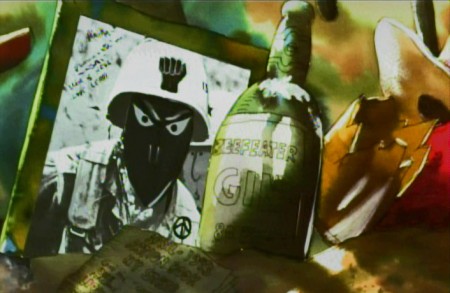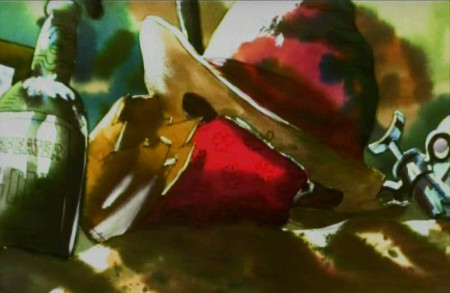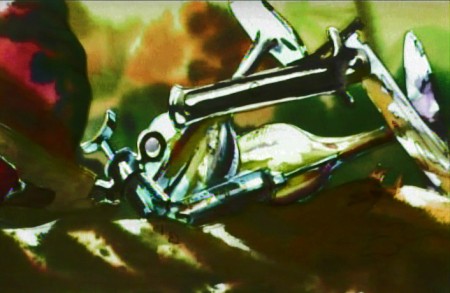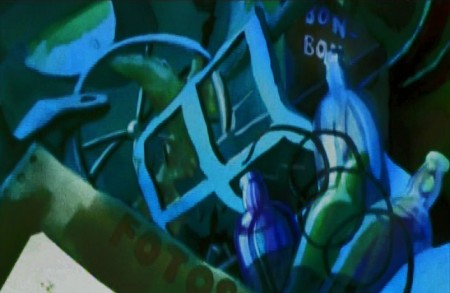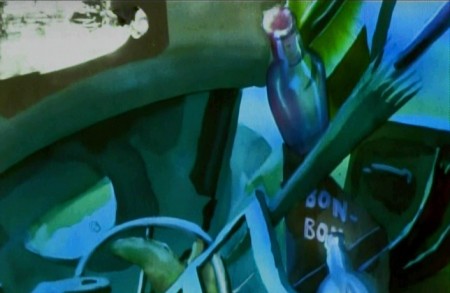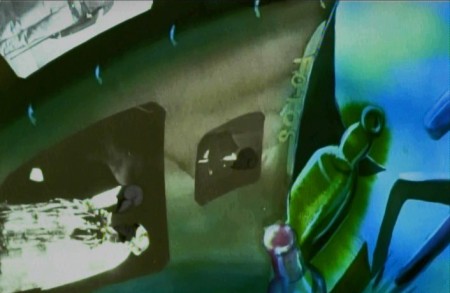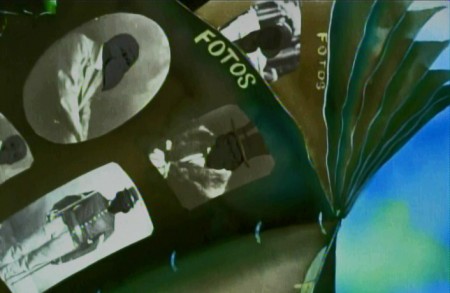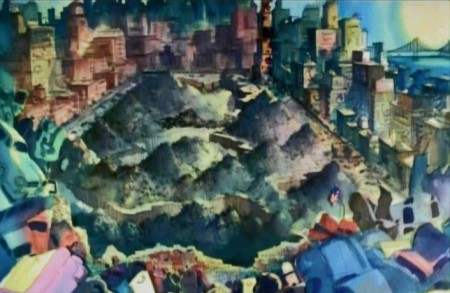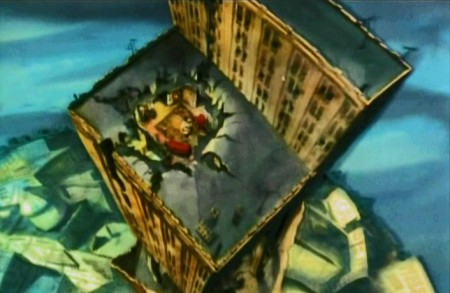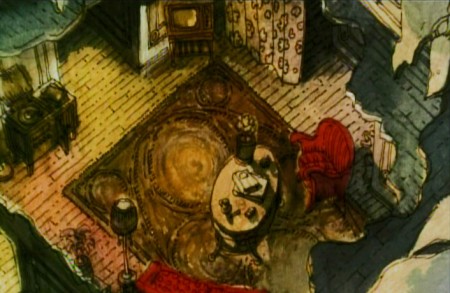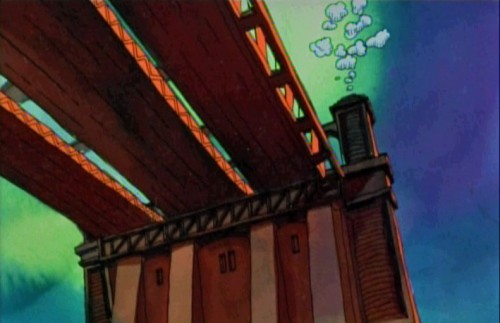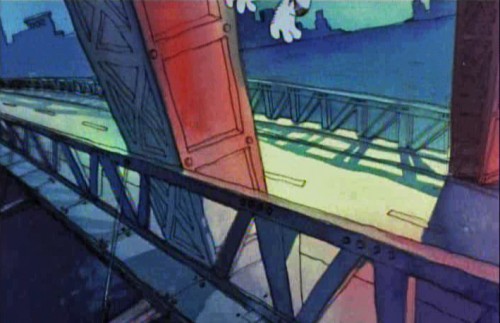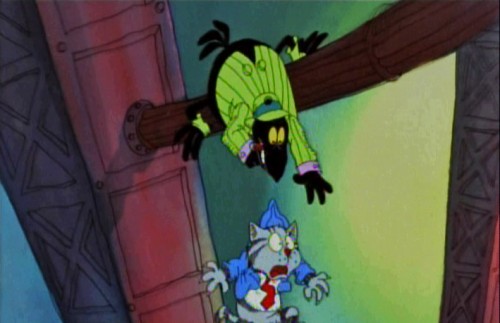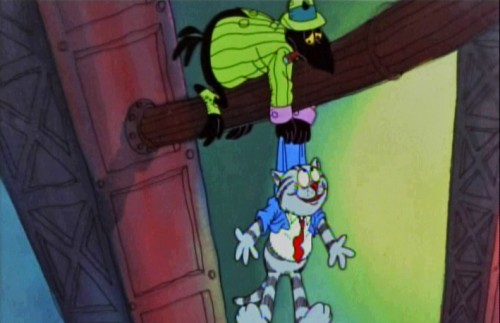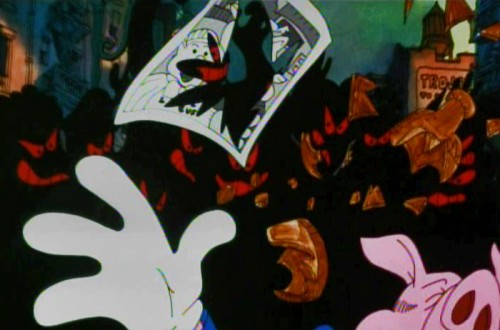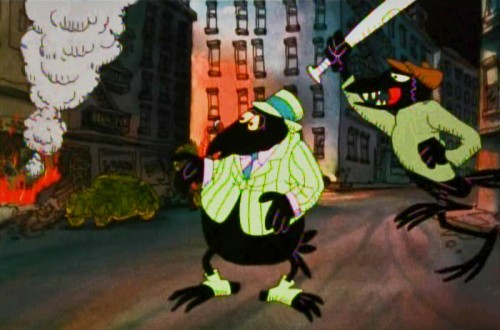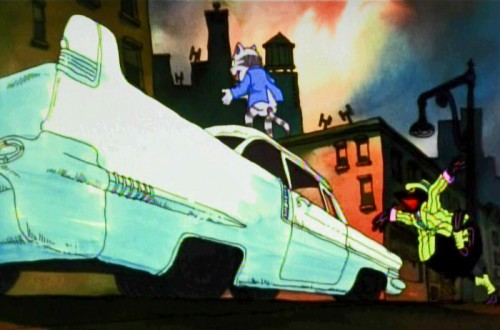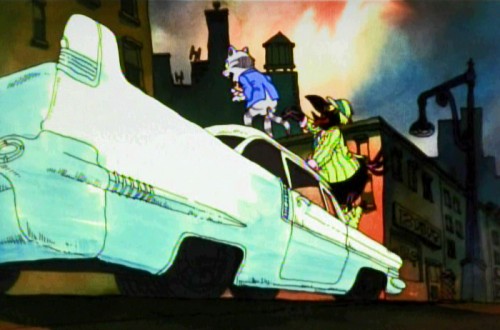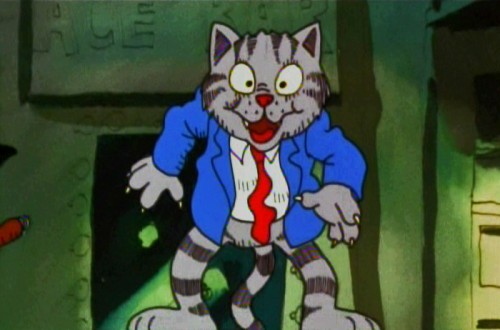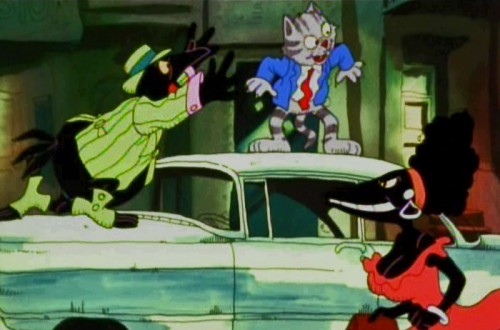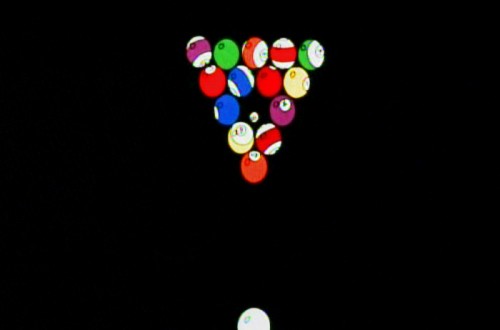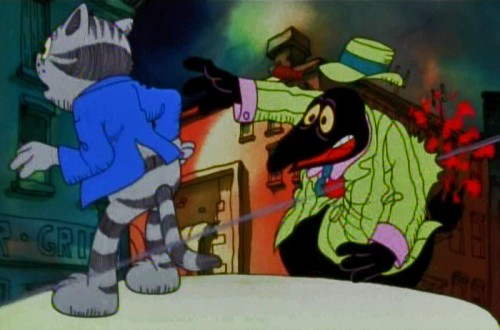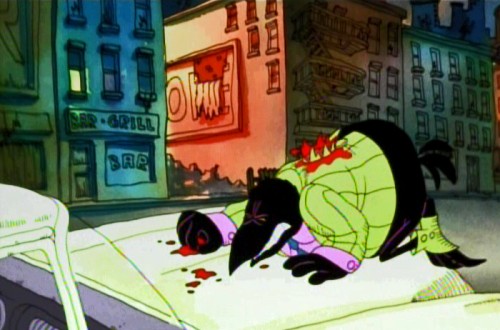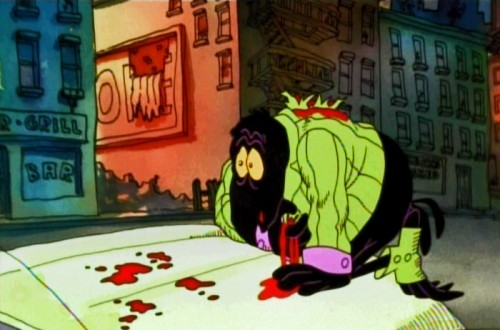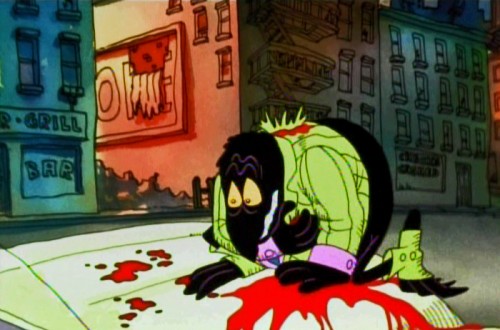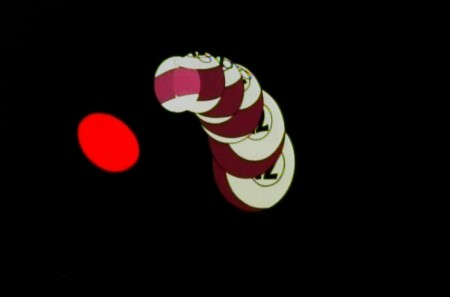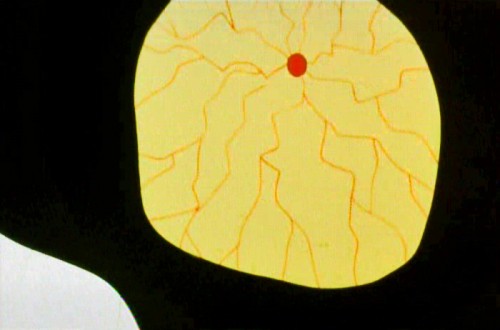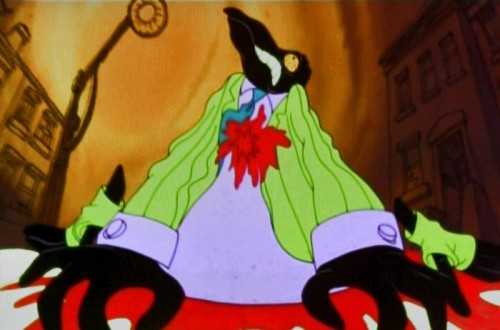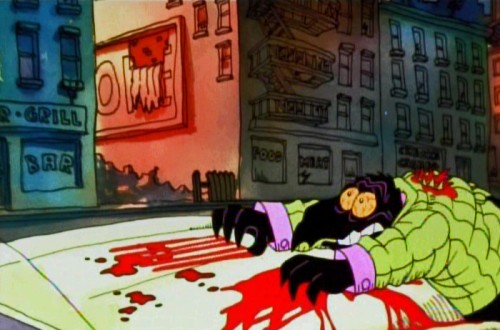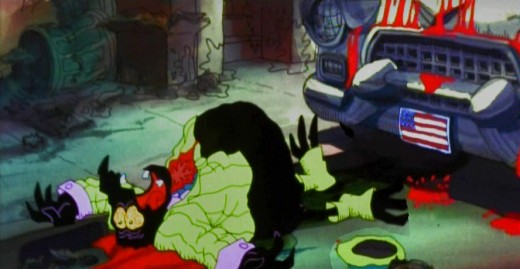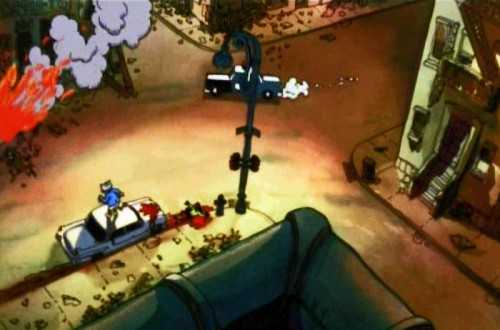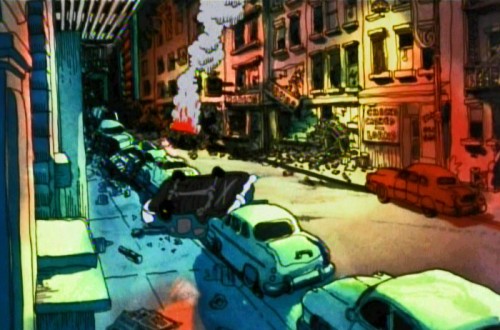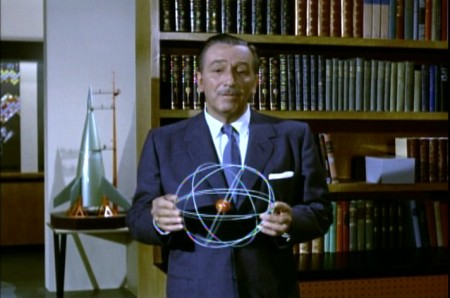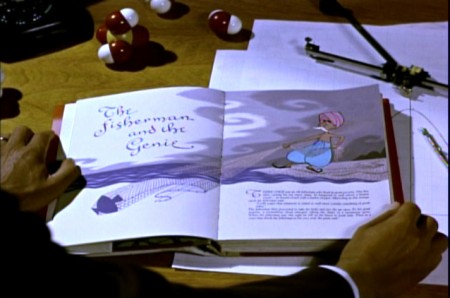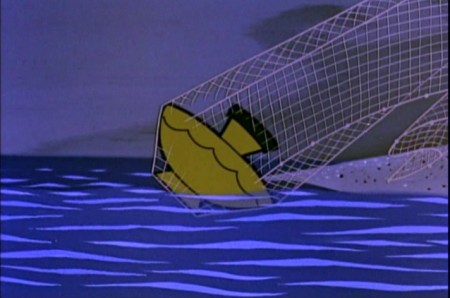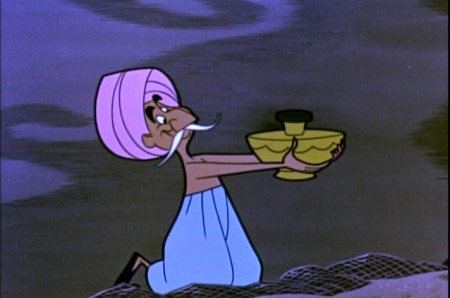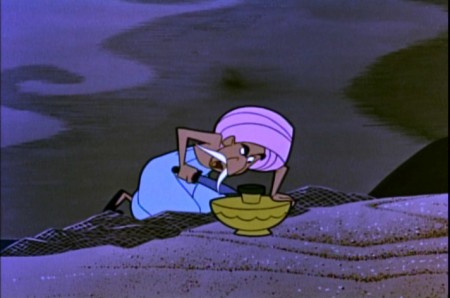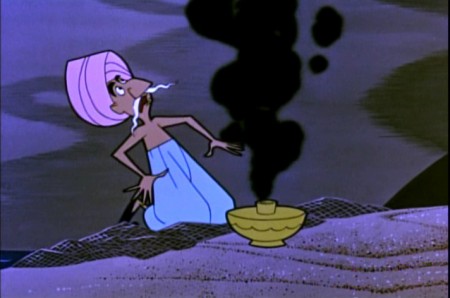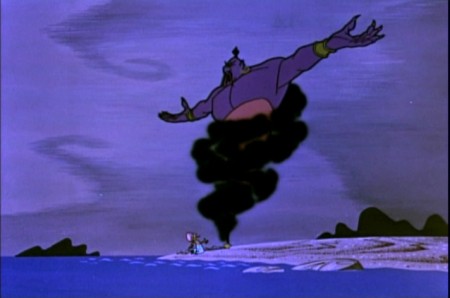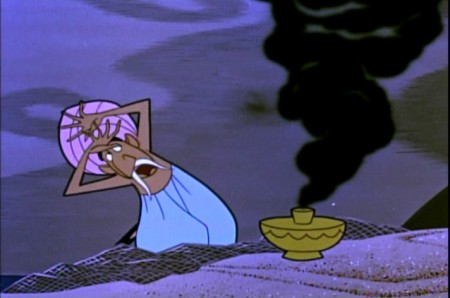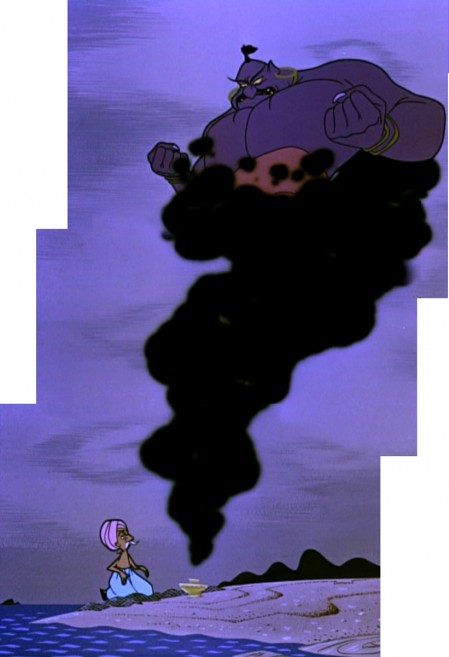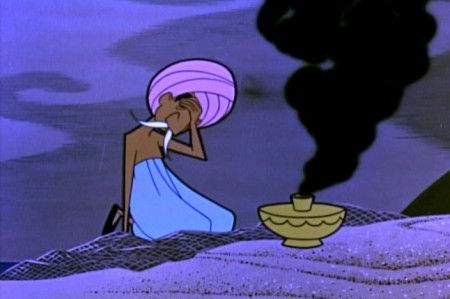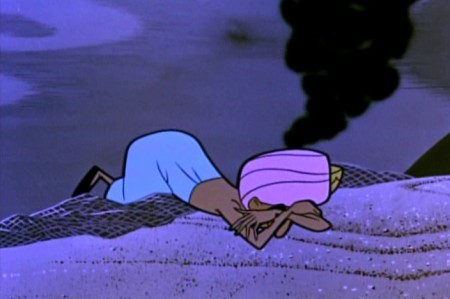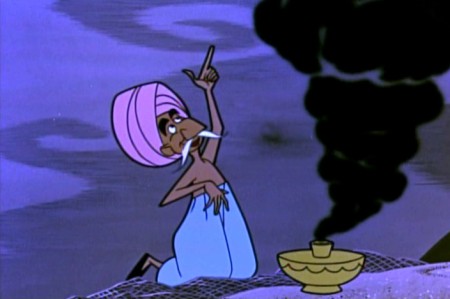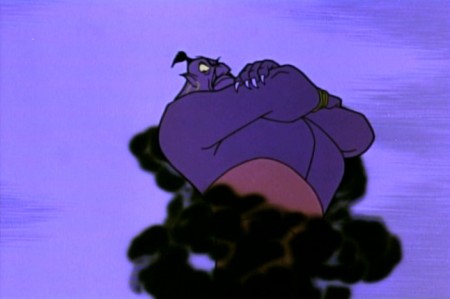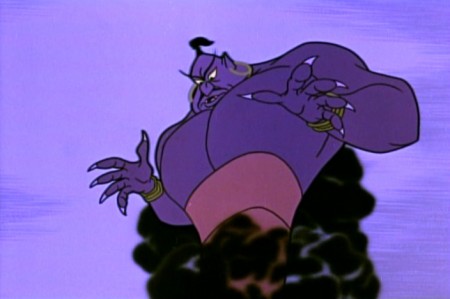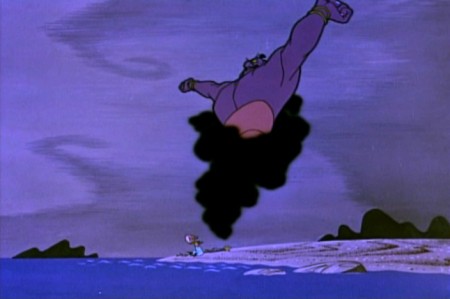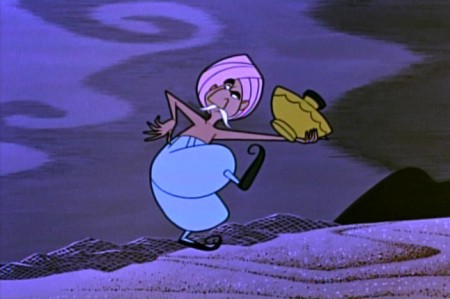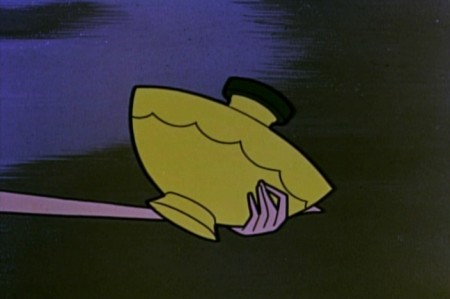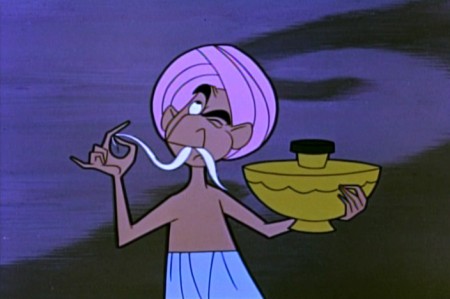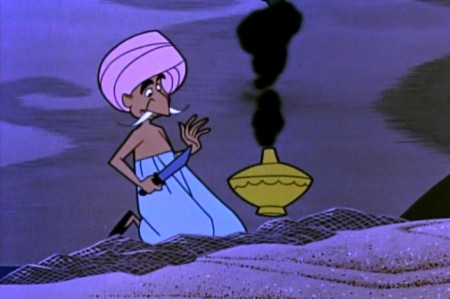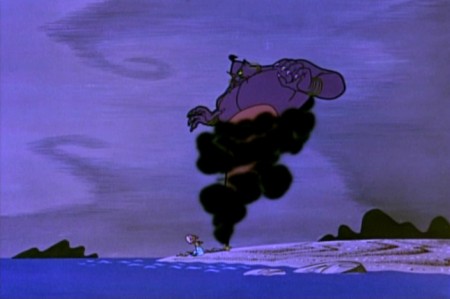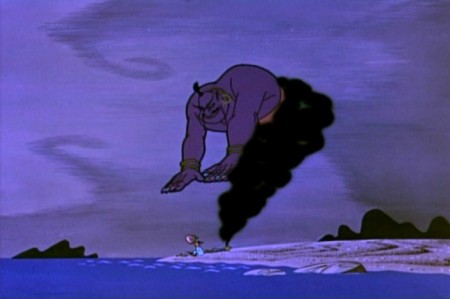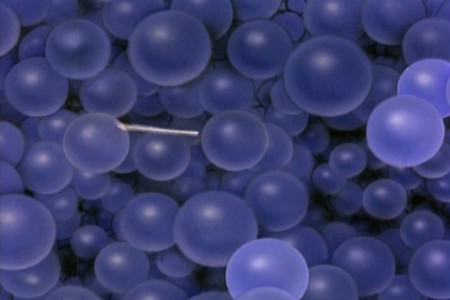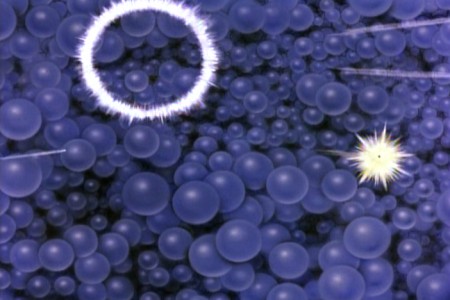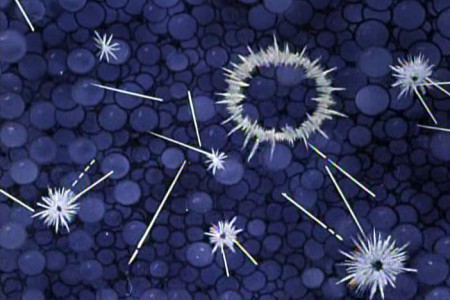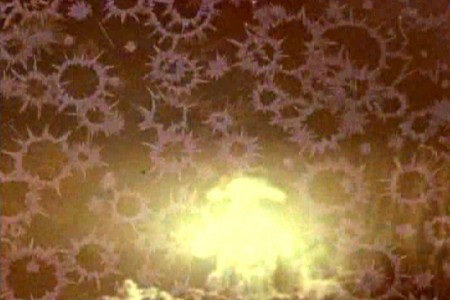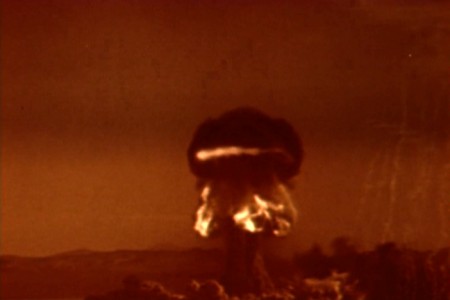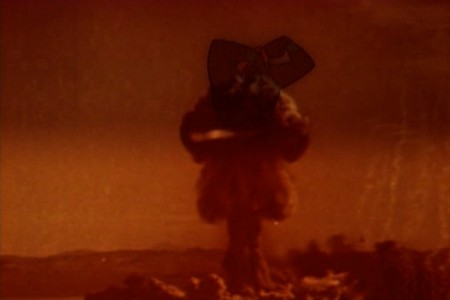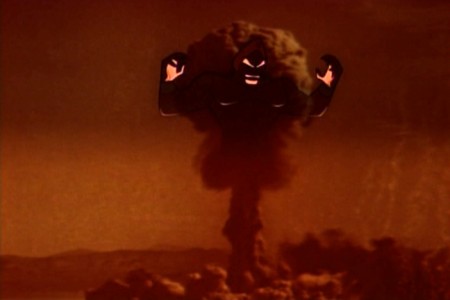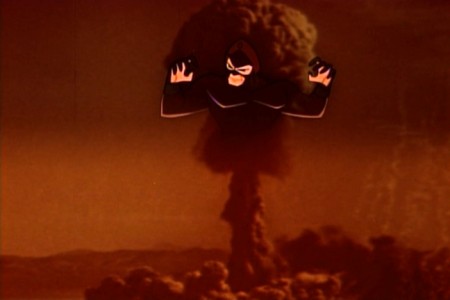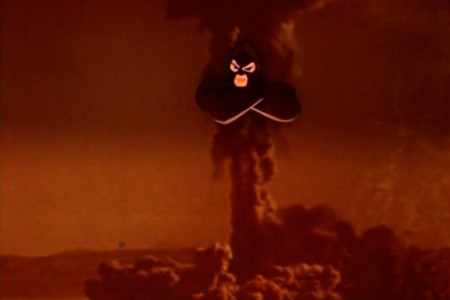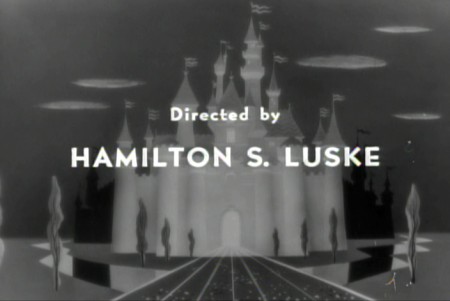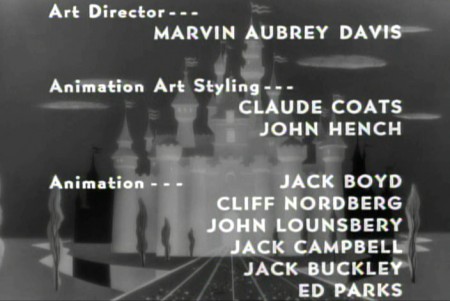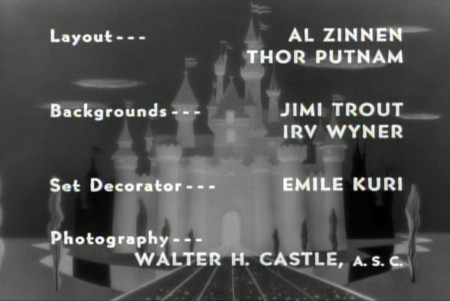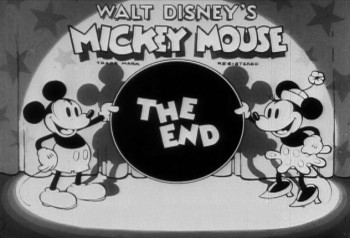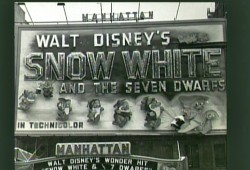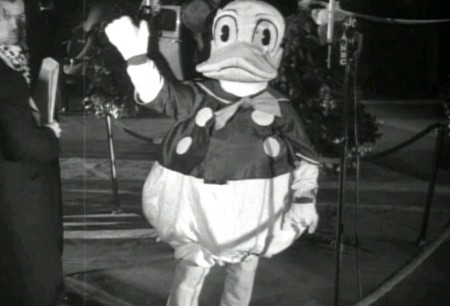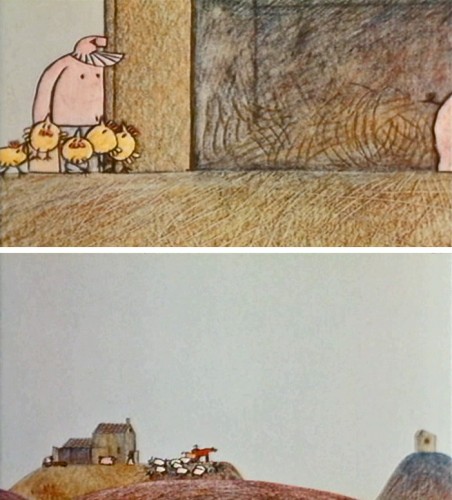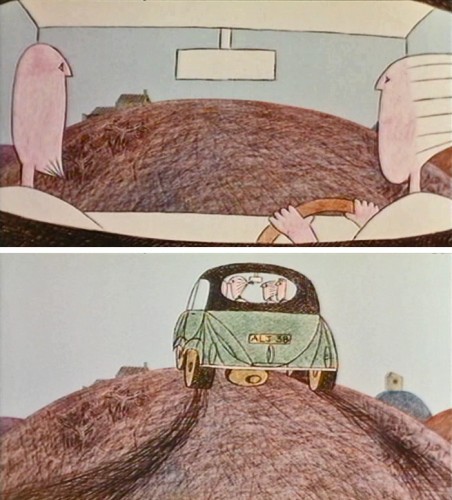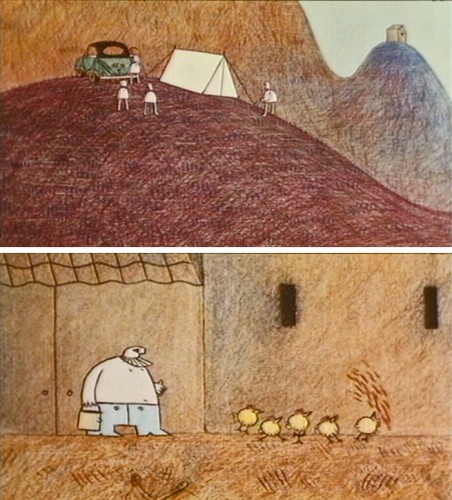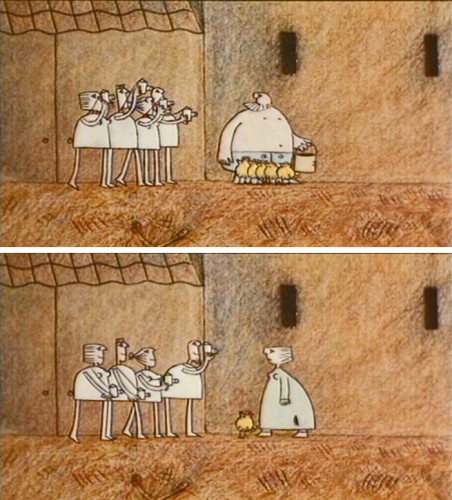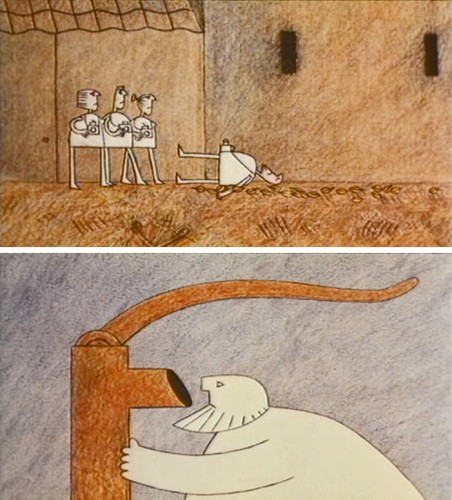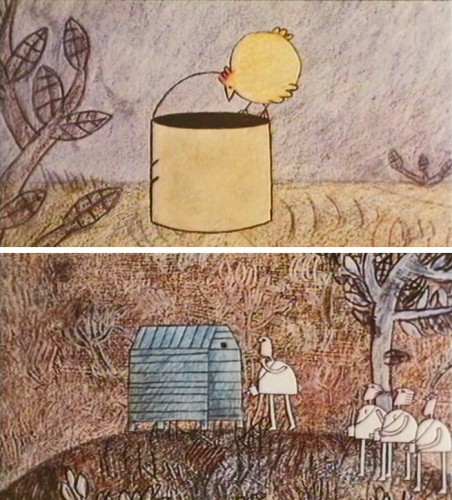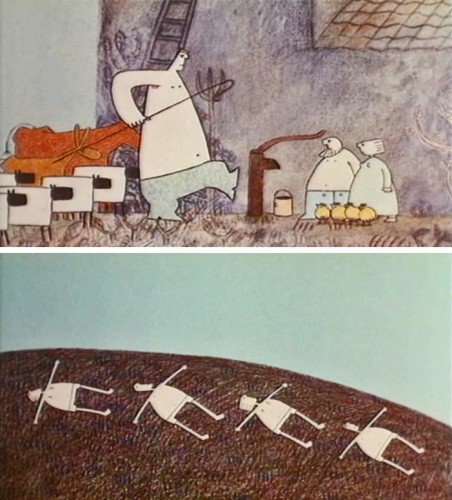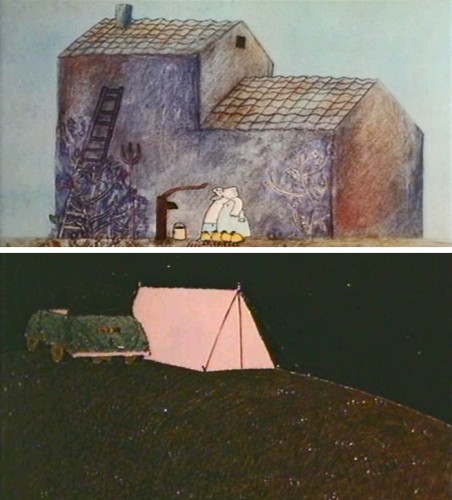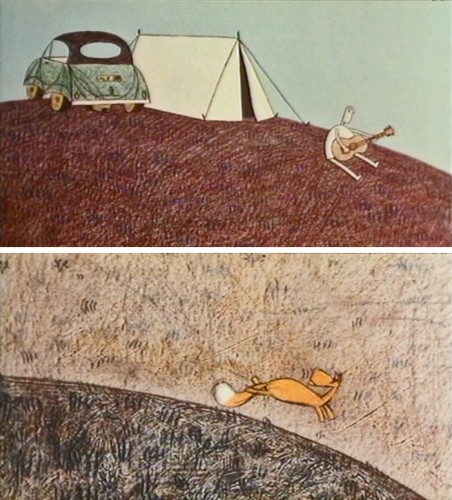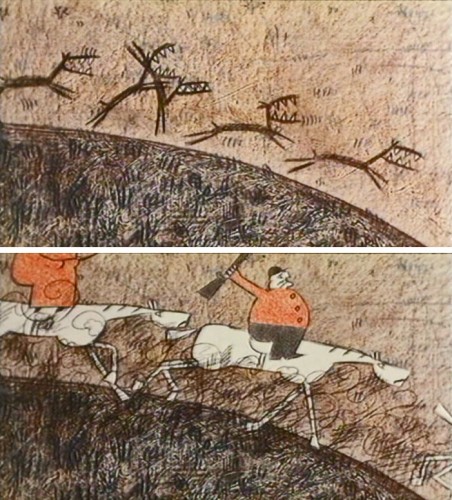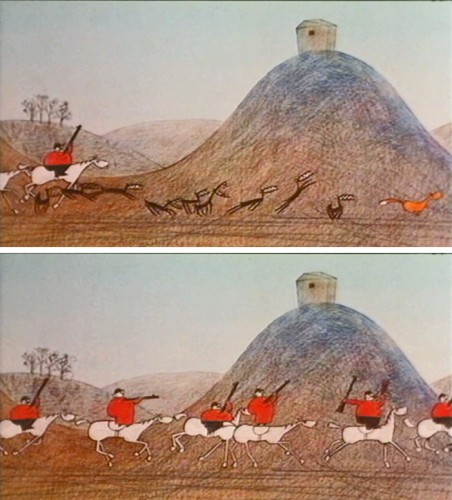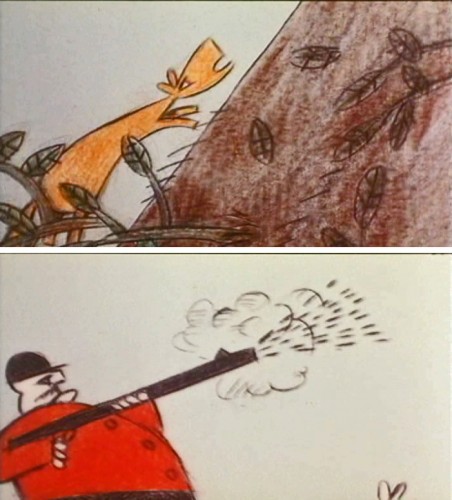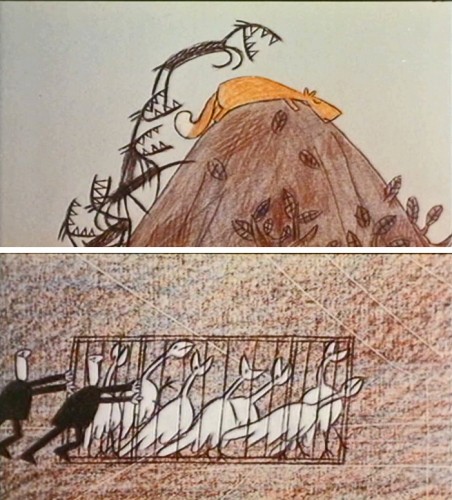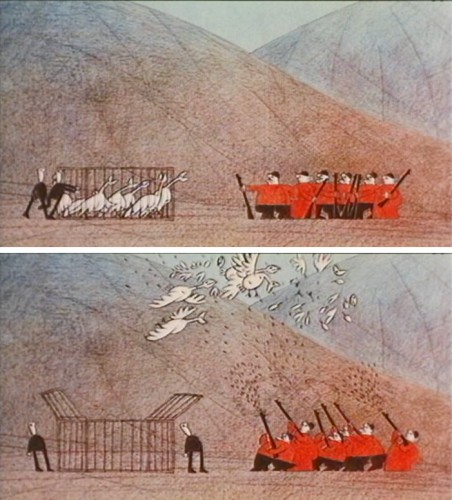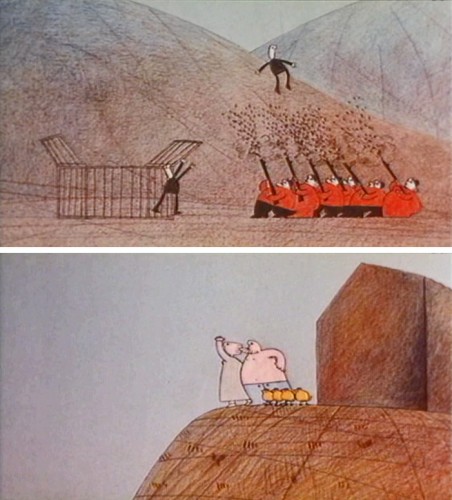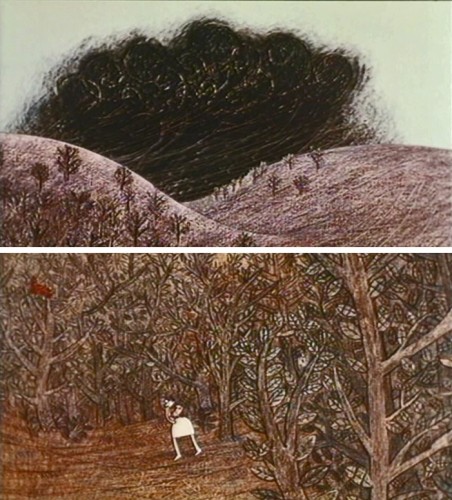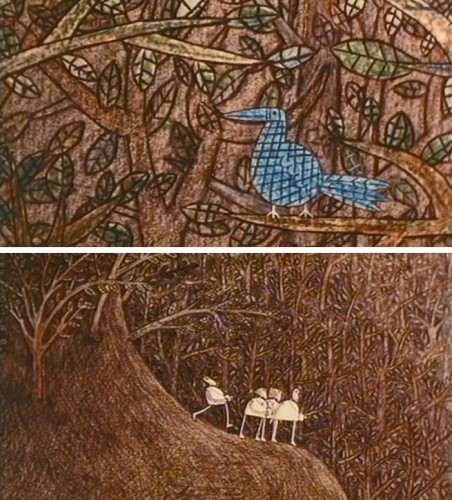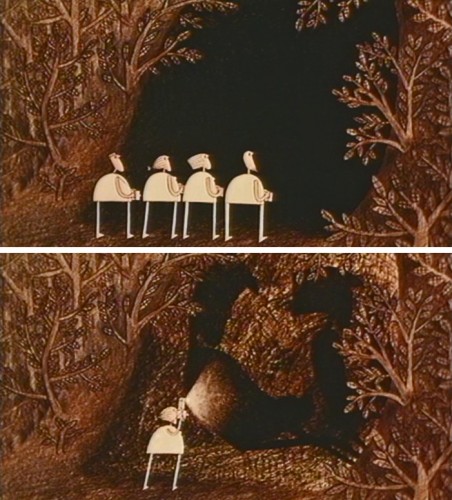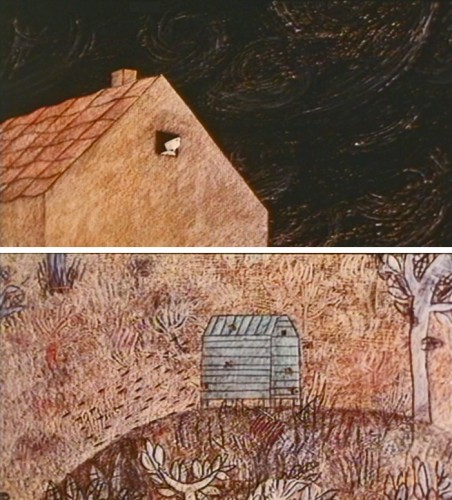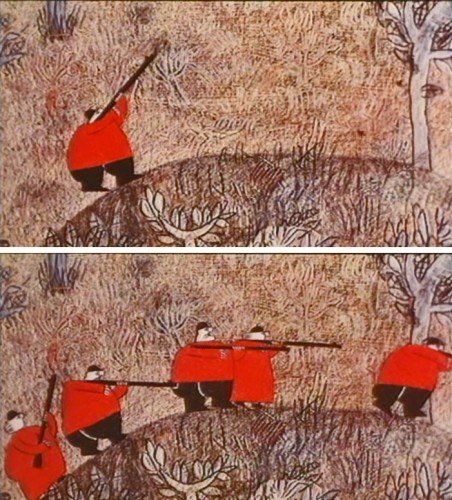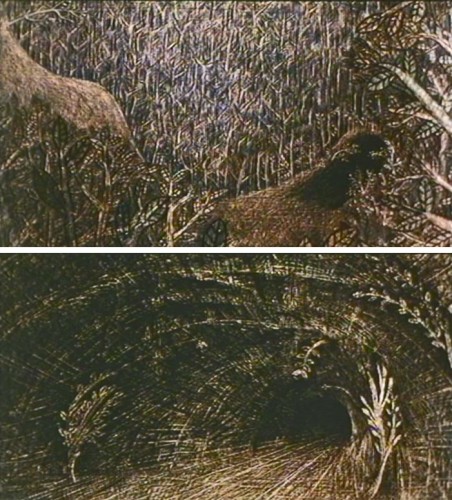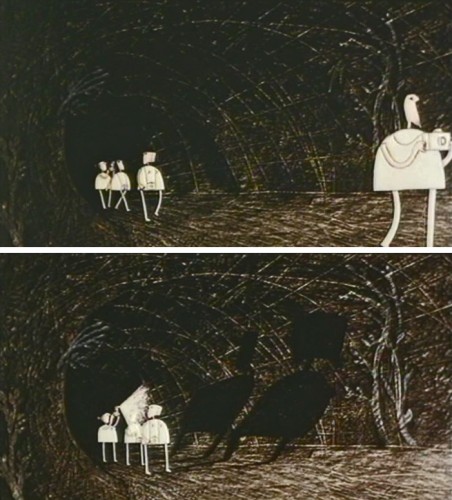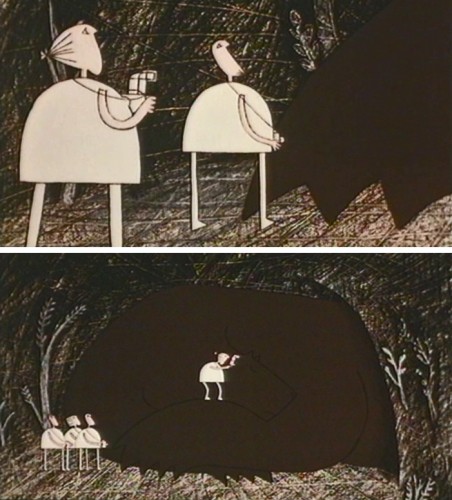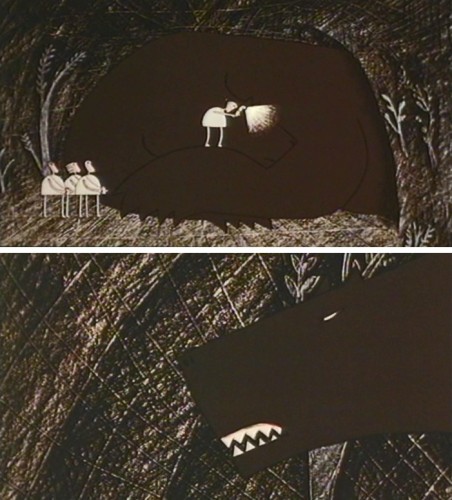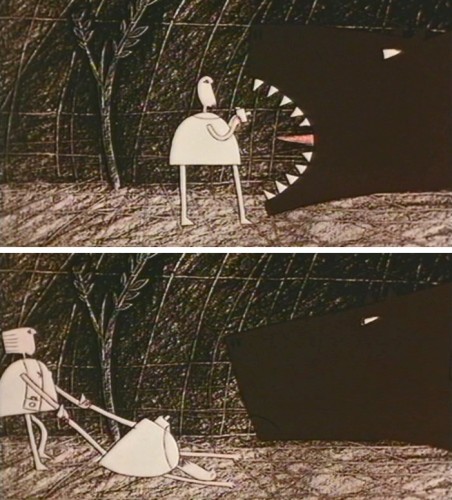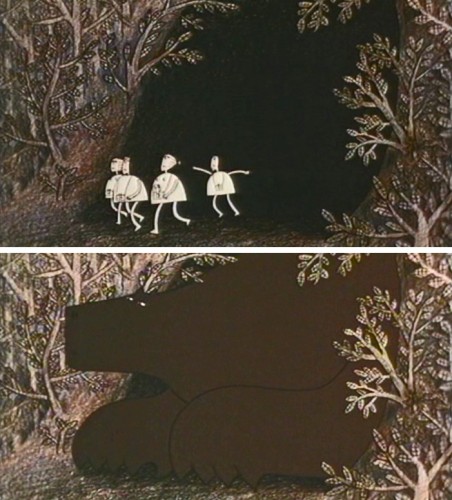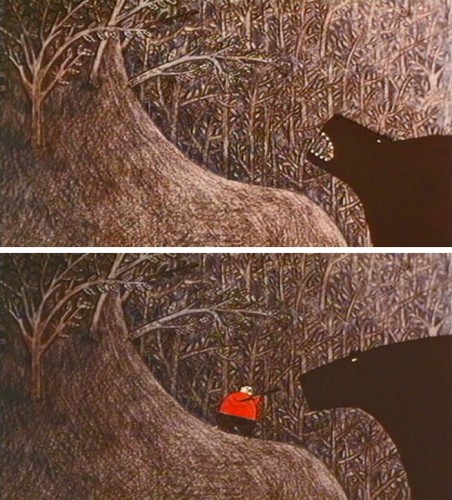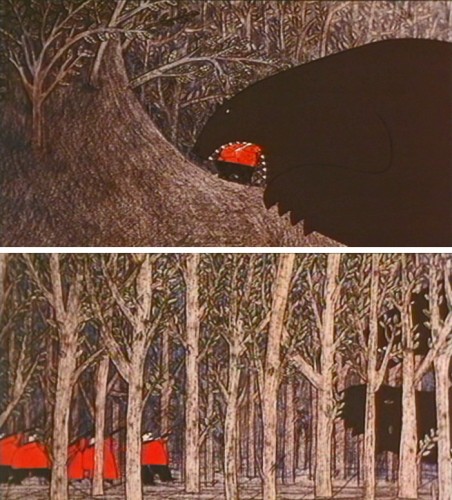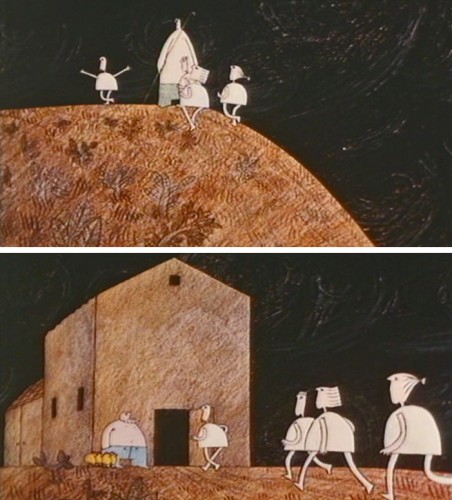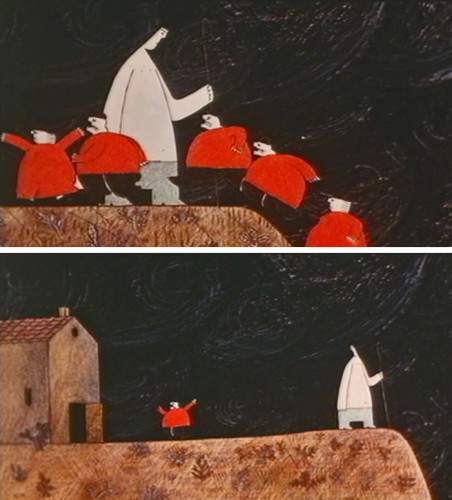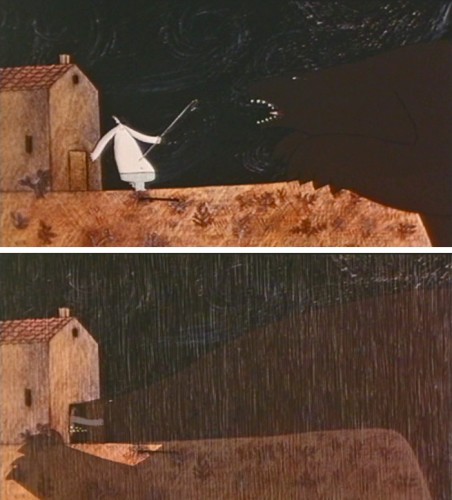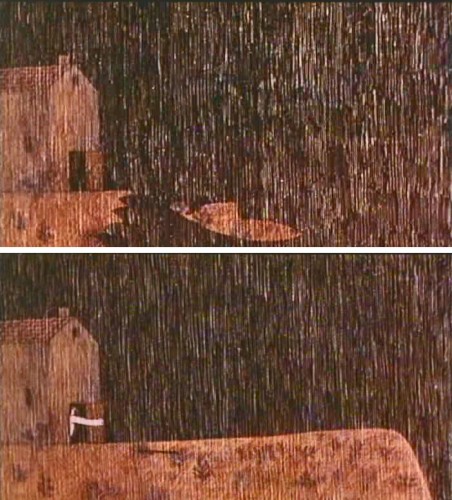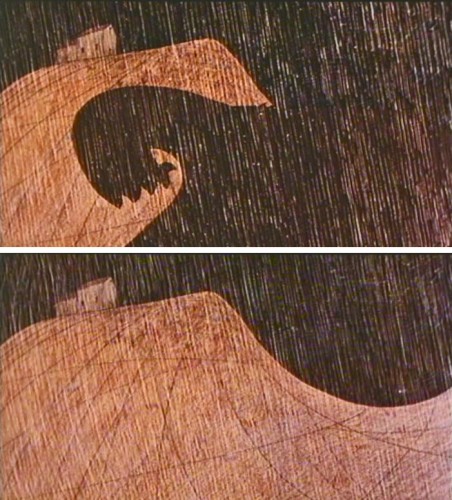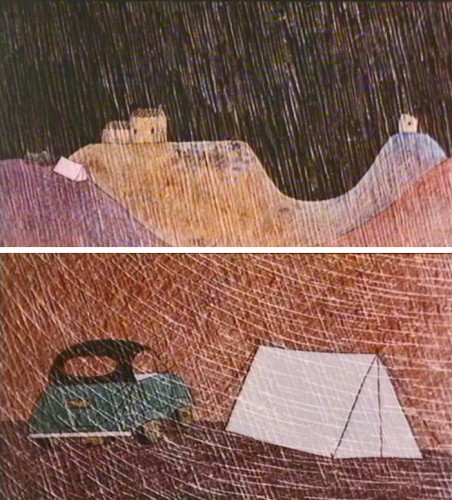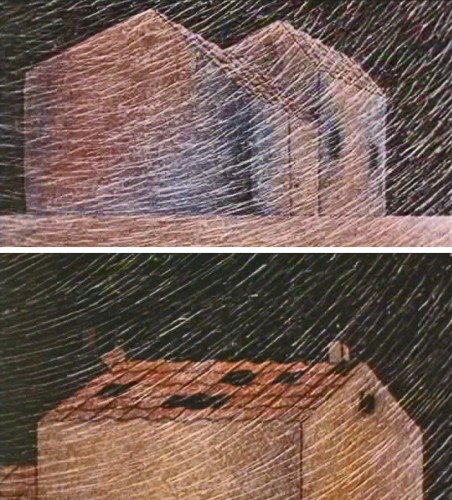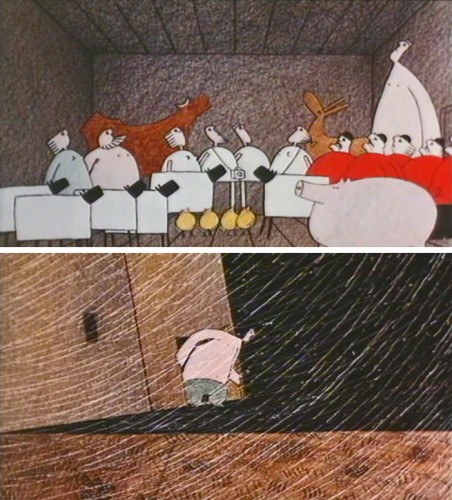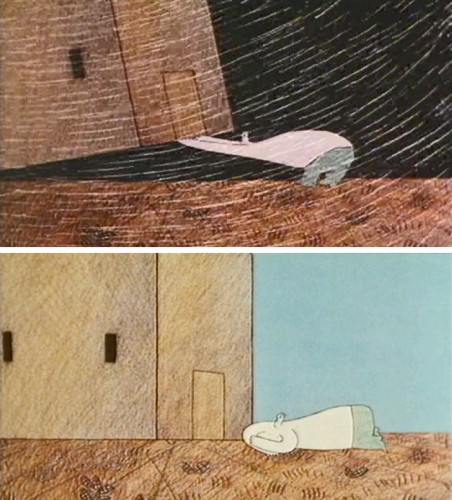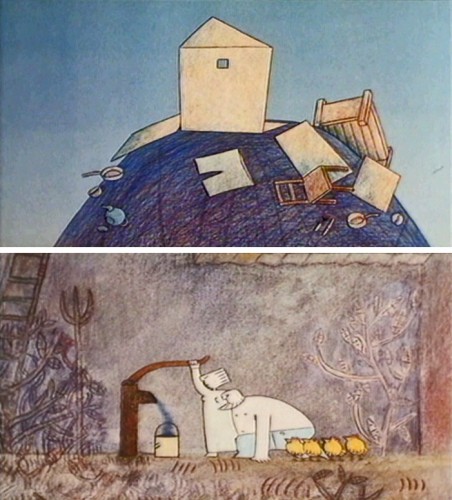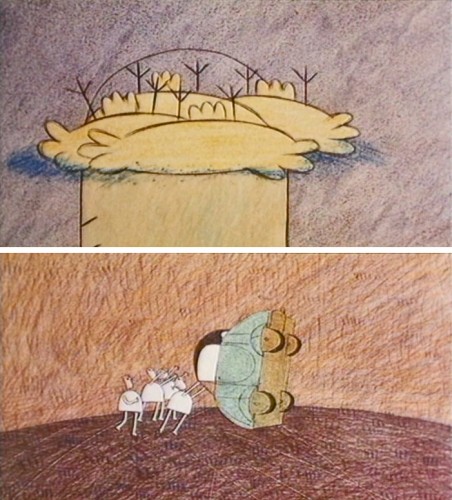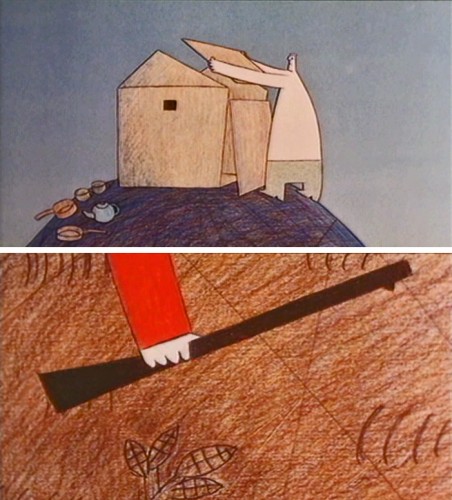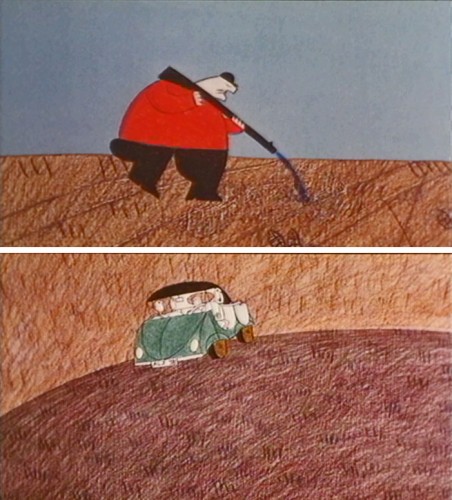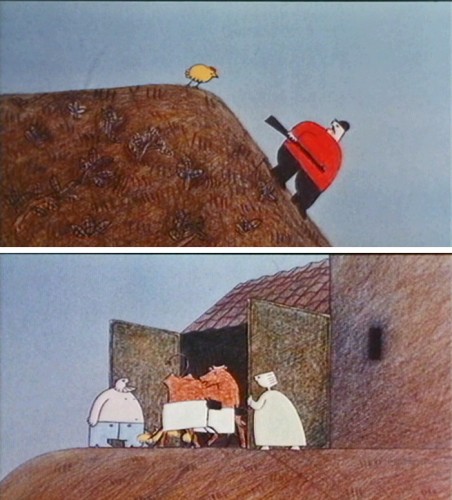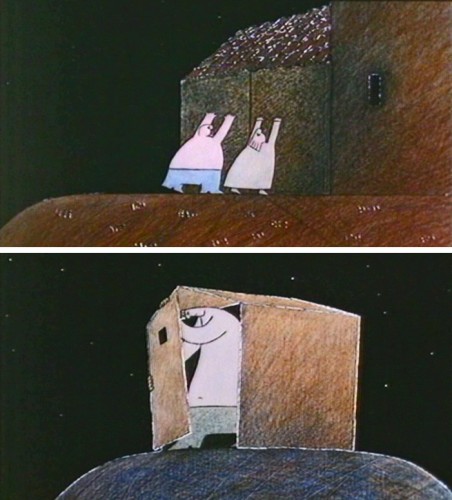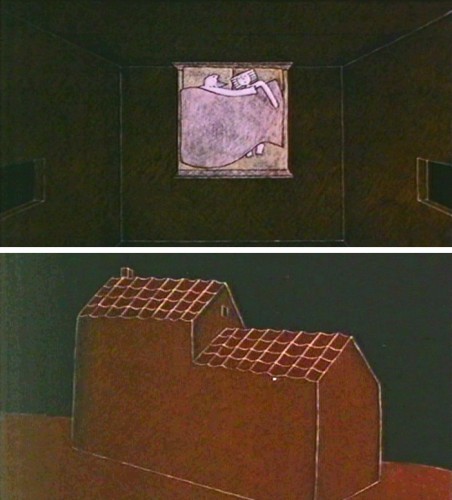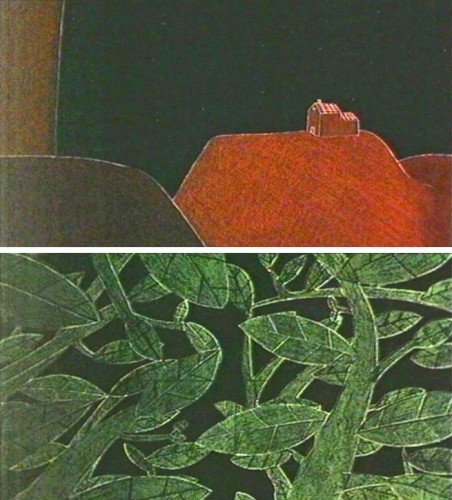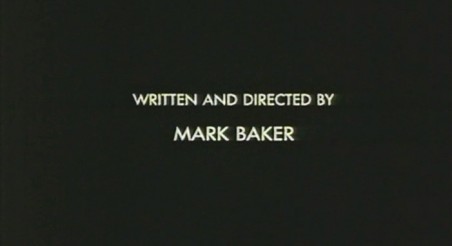Category ArchiveFrame Grabs
Frame Grabs &Models &UPA 14 May 2012 05:16 am
Magic Fluke Color Continuity
- The UPA Jolly Frolics DVD set includes a set of extras which showcases a good deal of artwork from the films. For the Fox & the Crow film, The Magic Fluke, there is a color continuity board by Herb Klynn which indicated how the art should be painted for the individual scenes.
This gave me the opportunity of putting the finished film side-by-side with the color continuity boad and find out where they diverge. (The numbered images with a letter attached {e.g. “2a”} are frame grabs from the movie.)
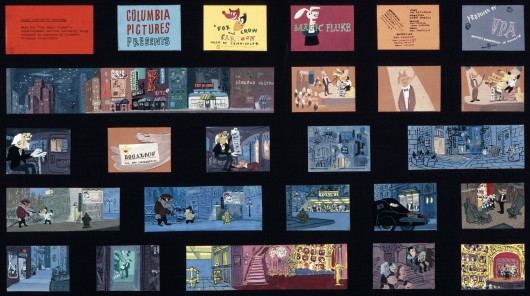
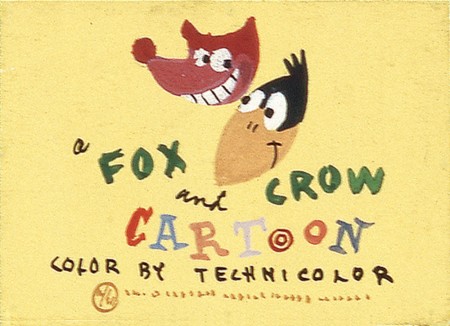 2
2
The differences start with the titles, right from the get go.
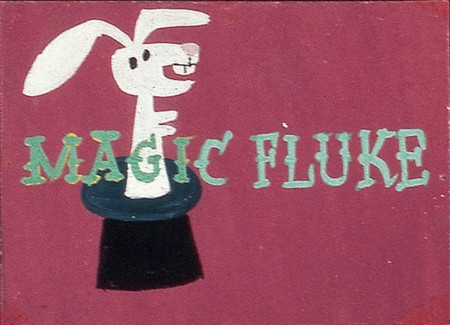 3
3
The color continuity board is much more creative.
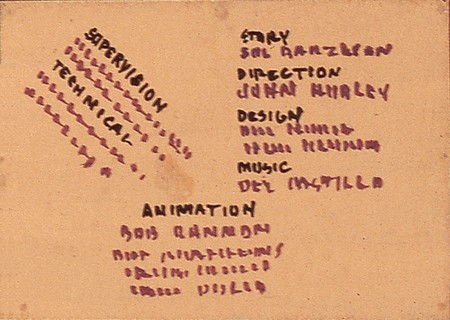 4
4
The final titles are a little dull. Fortunately, UPA’s films got
more creative with their titles once they really got going.

The final BG has the same move and ends with a truck in . . .
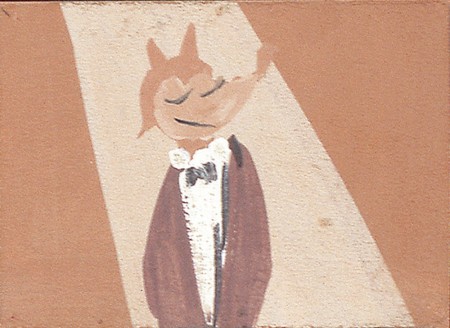 9
9
There’s no close up in there now.
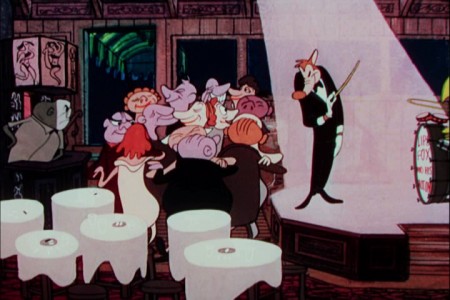 9a
9a
The audience pops from listeners to jazz dancers.
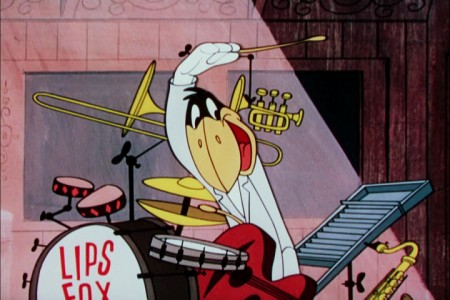 10b
10b
There is a close up of the crow playing wildly.
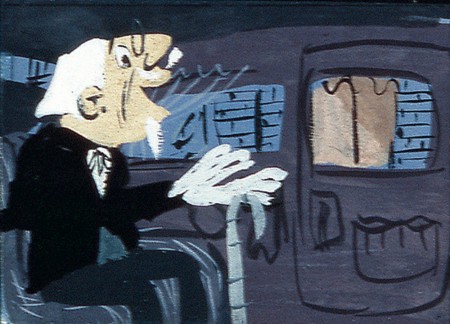 11
11
The impresario is no longer in the film.
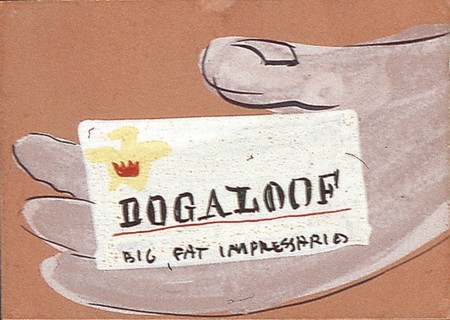 12
12
And he message comes from a taxicab, not a limo.
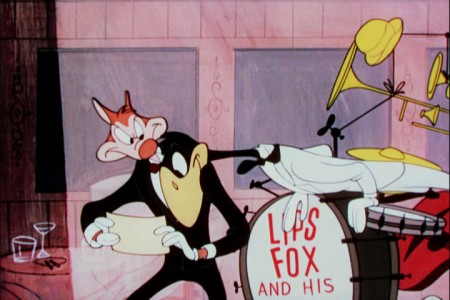 13b
13b
The fox reads the telegram from the stage and hides it from the crow.
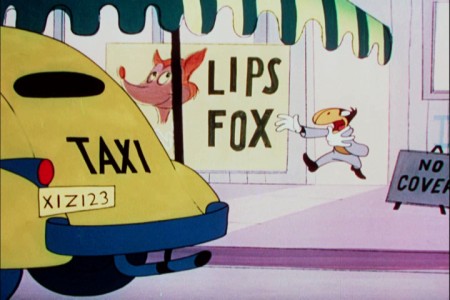 13c
13c
The crow chases the fox out the door as he leaves in a cab.
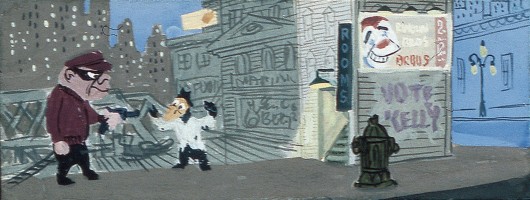
there’s no robbery in the film now. It just rains on a blue street.
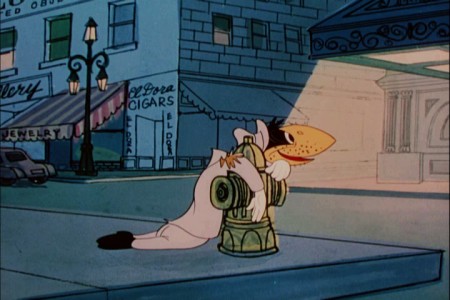 18a
18a
The crow ends up at the spark plug down and out.
He sees . . .
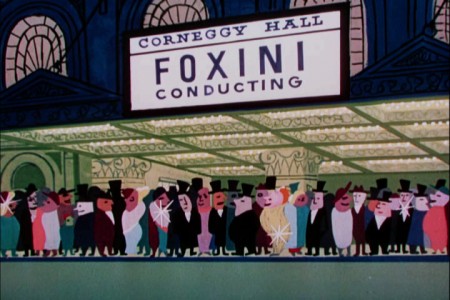 18b
18b
. . . the Foxini ppremiere.
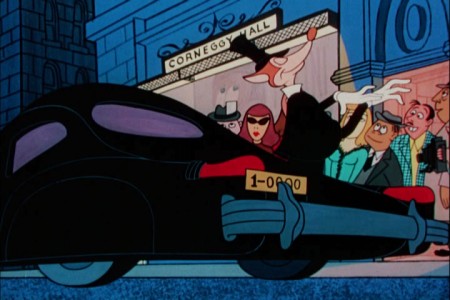 19a
19a
The Fox gets out of the limo.
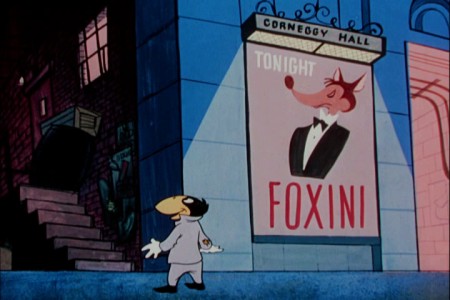 19b
19b
The crow looks up at the backdoor alley.
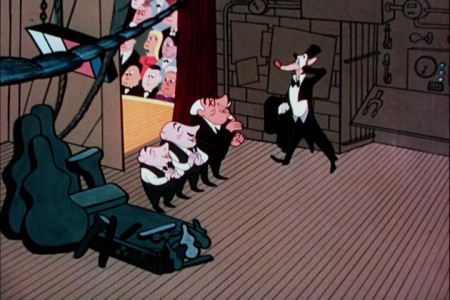 20a
20a
Foxini is greeted by his entourage, and he takes advantage of them.
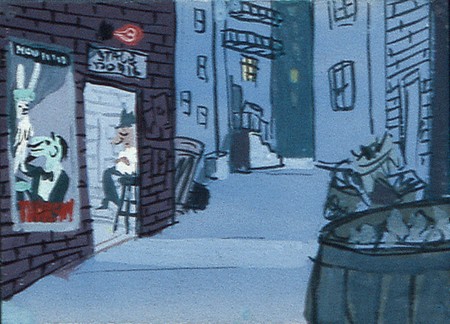 21
21
The back alley is about the same.

We no longer see a pan of the inside of the theater.
 23a
23a
There is a pan up the concert hall.
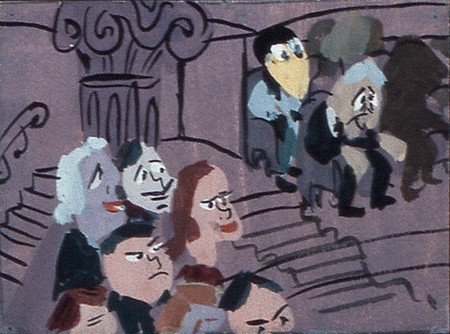 24
24
Crow arrives at the upper upper balcony . . .
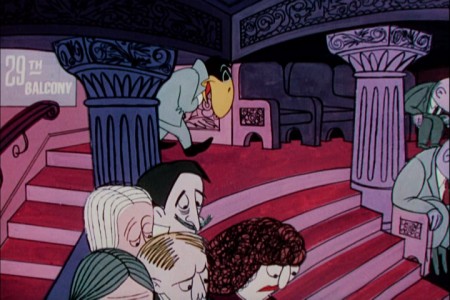 24a
24a
. . . and gets a last row seat.
Unfortunately, they only offered the color continuity board for the first half of the film,
and that’s as far as we could go.
Frame Grabs &UPA 07 May 2012 05:36 am
Julian’s Georgie
- Well, I’m following my fancy. I’m into Paul Julian‘s beautiful painting style, and have found a treasure trove in the UPA collection DVD, Jolly Frolics. Here I have one of the better UPA films, Georgie and the Dragon. It’s a rather simple story, beautifully directed by Bobe Cannon and animated by Rudy Larriva, Bill Melendez, Grim Natwick and Frank Smith. The exceptional script is written by three strong, animation pillars: John Hubley, Bill Scott and Phil Eastman. Paul Julian and Jules Engel seem to have done the backgrounds together.
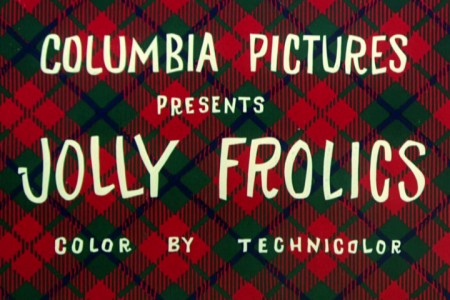 1
1The tartan BG with the yellow type sets up
the Scottish location for the film.
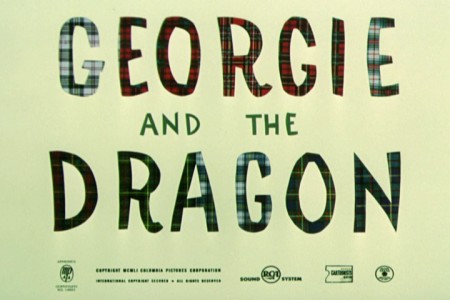 2
2
For the second card they reverse the scheme:
yellow BG with a tartan filled type.

The credits dissolve as the BG pans
and the camera slowly moves in.
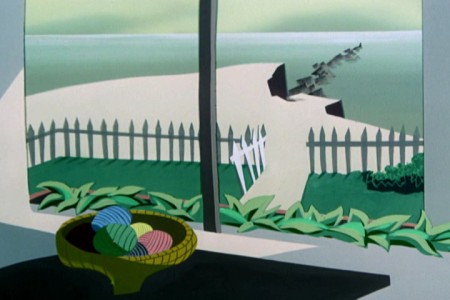 6
6
I think you can distinguish between the Paul Julian Bgs
and the Jules Engel bgs. Julian was more apt to use
drybrush in his work, and it gives it a singular look.
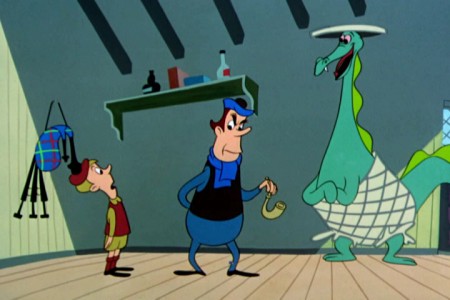 27
27
Just look at these wild poses even though
the characters are at rest.
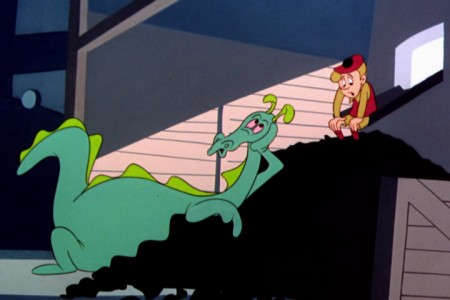 41
41
UPA didn’t just introduce a new kind of design,
it brought a new style of animation that made
that design work.
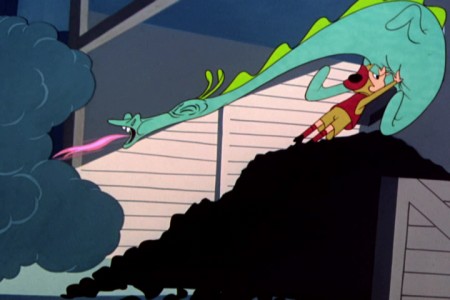 42
42
Bobe Cannon was the perfect animator to direct
the animators in this new looseness and sense of
graphic movement in animation.
Go here to see the comic book adaptation of the cartoon.
I found the following model sheets on Stephen Worth‘s excellent site, AnimationResources.
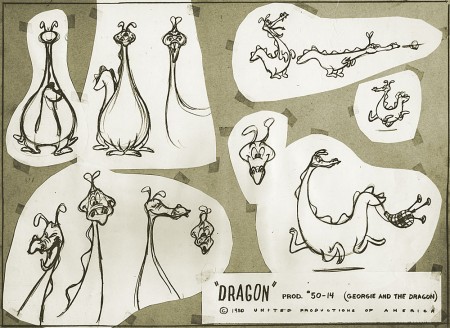
Frame Grabs &UPA 30 Apr 2012 06:14 am
Tell Tale Bgs
- Of all the pleasures I’ve gotten from the recently released UPA dvd Jolly Frolics the Backgrounds of Paul Julian are a particular enjoyment. His most famous and greatest achievement is, of course, the work he did on The Tell Tale Heart. This is his film. Ted Parmelee directed it, but I’m certain that he pretty much set the camera moves and timing, leaving all the design work for Julian.
I’m trying to feature Paul Julian’s work in a number of posts here, so today it’s The Tell Tale Heart.
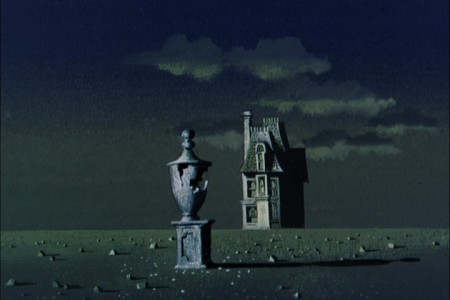 1
1
Animation Artifacts &Disney &Frame Grabs &Models &repeated posts &Story & Storyboards 12 Apr 2012 06:22 am
Some Lady Drawings – recap
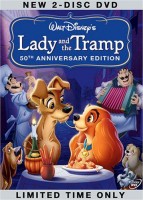 - The DVD of Lady and the Tramp includes some preliminary artwork for the film. I collected a bunch of it and am breaking it into a couple of posts. It’s easier to read off a blog than a tv screen, especially when the DVD tries hard to reduce them to the smallest size they can muster within an overworked border that is virtually pointless.
- The DVD of Lady and the Tramp includes some preliminary artwork for the film. I collected a bunch of it and am breaking it into a couple of posts. It’s easier to read off a blog than a tv screen, especially when the DVD tries hard to reduce them to the smallest size they can muster within an overworked border that is virtually pointless.
The illustrations – some are obviously BG layouts, others storyboard drawings – have a light and jaunty feel. They’re very cartoon in nature, and belie the actual feature they produced which, at times, is quite beautiful. Disney truly got the feel of “Main Street, USA” in this film.
I’m interested that most of the images don’t take in Cinemascope (since they were probably done before the decision to go Scope.) Most of them are also fast drawings that don’t feature the Tramp as we know him, and even Lady takes on a different form.
You get the feeling this film was pushed out relatively quickly. The results are excellent, regardless. Sonny Burke and Peggy Lee wrote an excellent pop-song score that doesn’t quite capture the turn-of-the-century, but it does capture the atmosphere of early 50s USA.
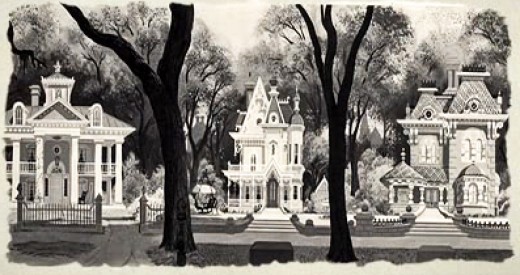
This drawing is in B&W on the DVD, but it appears in
Bob Thomas’ 1958 book, “The Art of Animation.”

Bg for The Princess and the Frog.
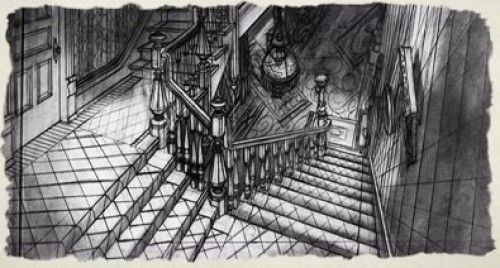
This looks not too different from a shot in Hitchcock’s Psycho.
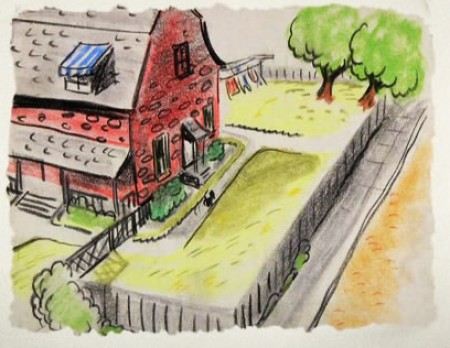
We seem to be in the Little Golden Book territory
with some of these images.
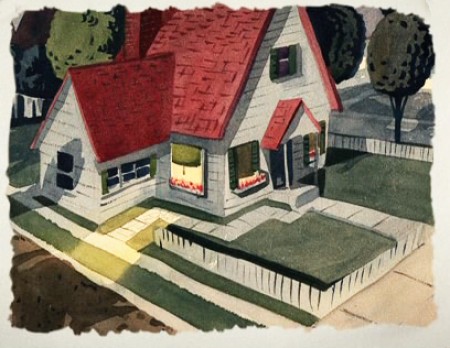
An earlier and different view.
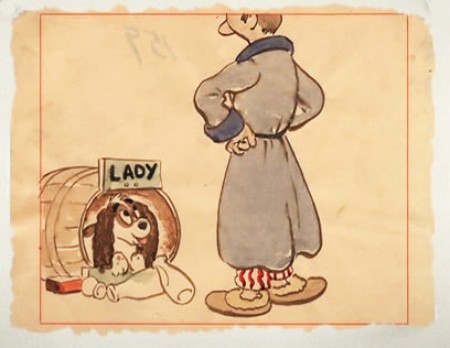
Or did I mean the New Yorker circa 1948?
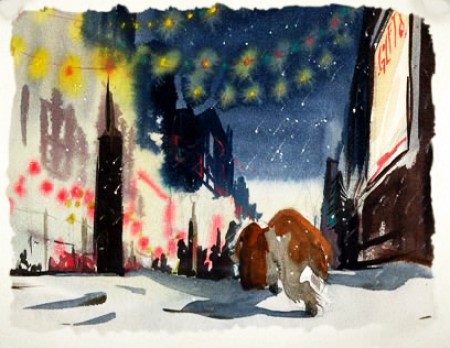
I love weather and would have applauded more of it in the film.
To be continued.
Animation &Frame Grabs &Independent Animation &SpornFilms 08 Mar 2012 05:48 am
Fritz BGs & Set Pieces
- For some reason I was inspired to watch some of Bakshi‘s Fritz the Cat, this past week. I remember posting in the past on a couple of the sequences.
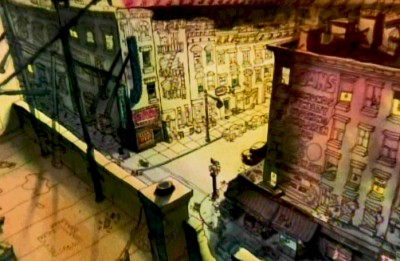 There was one on Johnny Vita‘s dynamic BGs at the time. They were a bit revolutionary for what they were. Johnny had gone through Greenwich Village with Bakshi photographing the environs. He then did a line drawing over the photos and painted the art under the lines, using Luma dyes. Bright shiny colors that he sometimes was able to mute. (It’s hard to tell the real colors from the DVD which all look like mud. I enhanced everything in photoshop to try to get colors that I remembered from 1972.) These were almost ragged versions of what Ken Andersen had done on 101 Dalmatians, but they were done on the fly. No time or money. Here’s that original post.
There was one on Johnny Vita‘s dynamic BGs at the time. They were a bit revolutionary for what they were. Johnny had gone through Greenwich Village with Bakshi photographing the environs. He then did a line drawing over the photos and painted the art under the lines, using Luma dyes. Bright shiny colors that he sometimes was able to mute. (It’s hard to tell the real colors from the DVD which all look like mud. I enhanced everything in photoshop to try to get colors that I remembered from 1972.) These were almost ragged versions of what Ken Andersen had done on 101 Dalmatians, but they were done on the fly. No time or money. Here’s that original post.
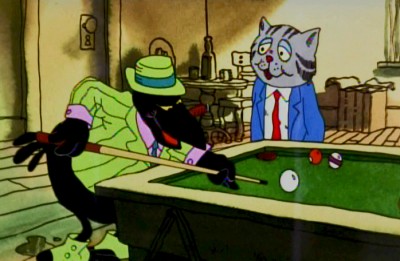 Then I did one on a scene in a bar where Fritz meets Duke, the crow, who will not only save his life but will take a bullet at Fritz’ sheer stupidity. Here are some drawings from Marty Taras of that scene.
Then I did one on a scene in a bar where Fritz meets Duke, the crow, who will not only save his life but will take a bullet at Fritz’ sheer stupidity. Here are some drawings from Marty Taras of that scene.
Then, I also did a post on some storyboard drawings of the bathtub orgy at the film’s beginning. You can find those drawings here.
Here’s another set piece, a series of pans. I’ve hooked a couple of the pans together, but have kept many as single frame elements to be better seen. A whole melange of styles mixed in here, and no doubt Bakshi had seen what Hubley was doing to pan through screen time.

Opening part of a multiple exposure pan.
Then there’s the flight over the Brooklyn Bridge where Fritz crashes the car and the Duke saves Fritz’ life.
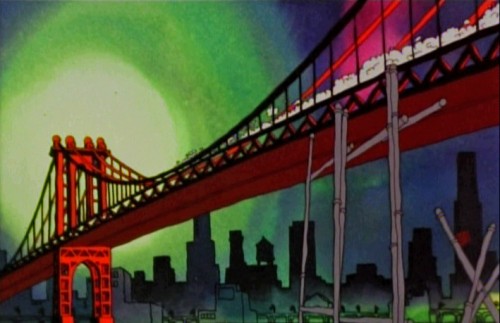 1
1
And finally, we have the best set piece of the movie. The climax that falls in the middle of the film, and the rest of the film can’t get over it.
Minor mayhem breaks out in Harlem, Duke gets killed, accidentally, and a riot breaks out. It’s all Fritz’ fault, of course, and he naturally runs from the scene at the end of the sequence.
Cosmo Anzilotti, the AD told me that this was Jim Tyer‘s scene. It doesn’t quite look like his work – rock steady and beautiful. I can and do believe that it is his work. Some great great poses.
Supposedly, Tyer hated working on the film. He was a die-hard Catholic who hated the cursed animation being done. Bakshi loved Tyer, as well he should have.
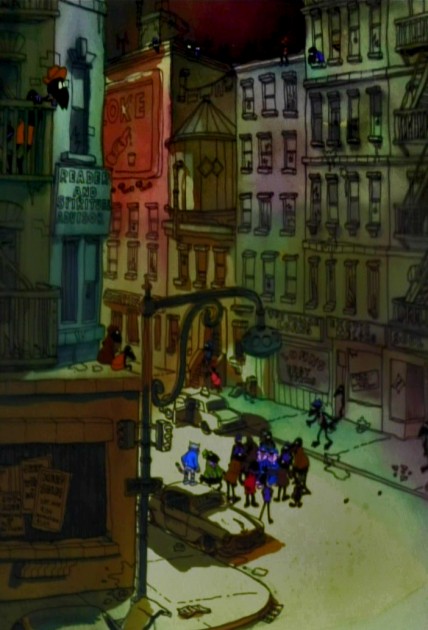 1
1
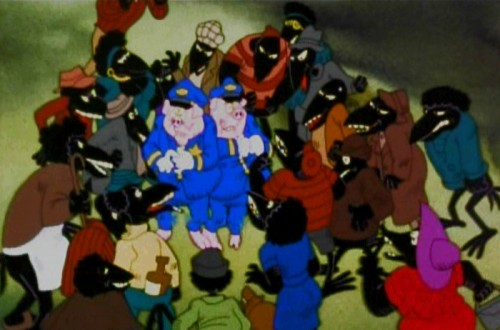 2
2
The cops are pushed into a corner.
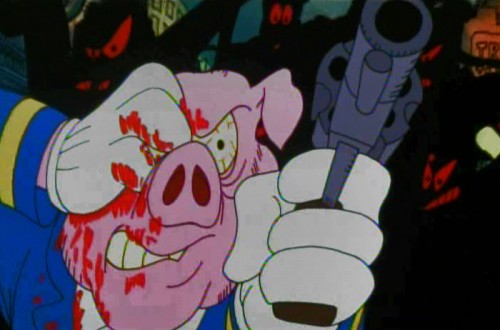 4
4
. . . who pulls out a gun and fires.
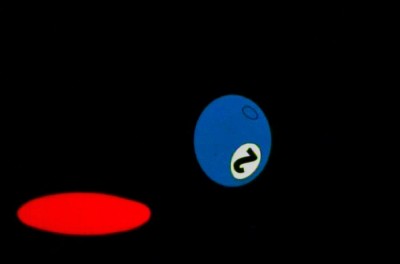 15
15
The metaphor of pool balls sinking into their holes
represents Duke’s last breaths on earth.
The most important piece of writing on Fritz the Cat is an older piece done by Mike Barrier and readily available on his site. Read it if you have any interest in the film. Part 1 – Part 2 – Part 3 -Part 4 – Part 5
- Ah you didn’t think I’d forget the HARD SELL, did you? Unfortunately, I can’t. I am trying to get my little epic into the production hard line.
POE is a telling of Edgar Allan Poe’s short life story, and we’ve done a lot of art and preparation. Now we want a couple of minutes of good final product to show how great it’ll be.
Kickstart POE is the project in the works, and I need your help. Please take a look at the page, give any small support you can, even if it’s just to tell your friends about it.
Many thanks.
Animation &Disney &Frame Grabs 27 Feb 2012 08:22 am
Our Friend the Atom
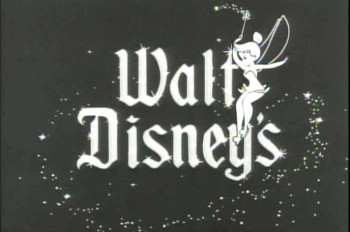 - When Disney released 20,000 Leagues Under the Sea, there was a curious and opportune time for some cross promotion with Disney doing a “Tomorrowland” show for his Disneyland program. Our Friend the Atom talks about atomic energy driving the Nautilus submarine in the Jules Verne film that Disney was pushing. (Of course, Verne wrote of an “electric ship,” but Disney in the mid-fifties had to be thinking nuclear.)
- When Disney released 20,000 Leagues Under the Sea, there was a curious and opportune time for some cross promotion with Disney doing a “Tomorrowland” show for his Disneyland program. Our Friend the Atom talks about atomic energy driving the Nautilus submarine in the Jules Verne film that Disney was pushing. (Of course, Verne wrote of an “electric ship,” but Disney in the mid-fifties had to be thinking nuclear.)
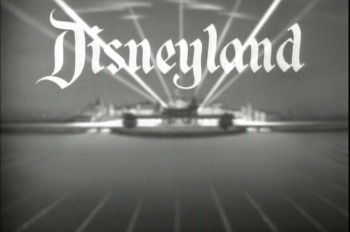 Ham Luske directed the
Ham Luske directed the
show, and I have to say some of the animation is spectacular. I really love the look of this stuff. I feel like the representation of the Genie is magnificent. There’s a feeling that they capture which really invokes the Arabian Nights figure that I read. (I was a bit turned off by the WB feel of the Robin Williams Genie in Aladdin, though I am in awe with what Eric Goldberg did with it. I guess I’m too much of a purist with some of these folk/fairy tales.)
I had always given Ward Kimball credit for the show until looking at it again. Whereas all the shows Kimball did had a light approach toward the science, trying to make it as much fun as possible, Our Friend the Atom is dead serious with very little humor underneath it. Somehow, I loved this show more and was very impressed with the strength of that Genie.
I’ve taken some frame grabs of the first segment to give an idea of it. The show is available in one of those Walt Disney Treasures – Tomorrow Land: Disney in Space and Beyond
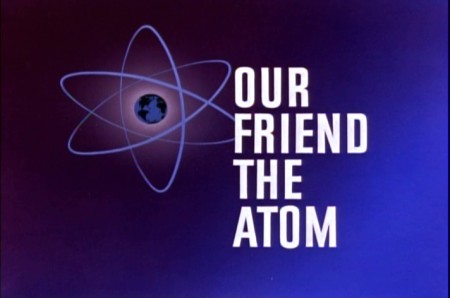 1
1
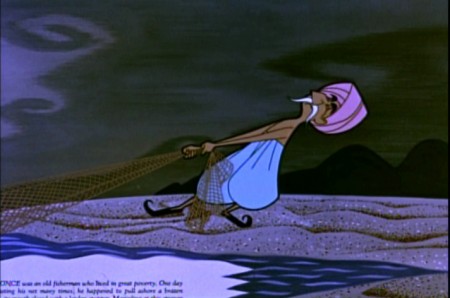 4
4
Note how they keep the type in the book illustration as they did
in the Winnie the Pooh adaptations which were done years later.
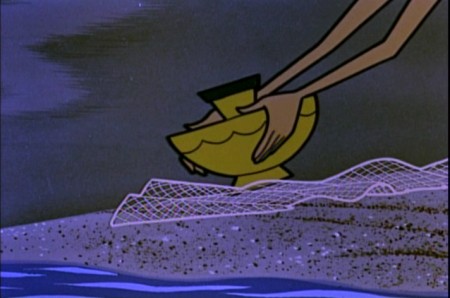 6
6
Just pure fine visual storytelling in this section.
It really is very well done in its conservative editing.
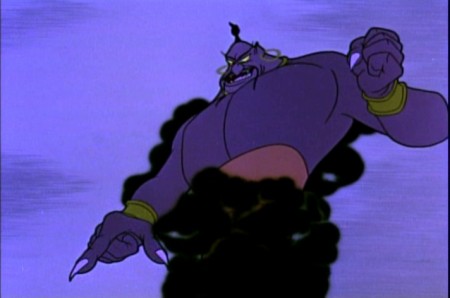 11
11
The Genie is going to take advantage of the fisherman
who has released the demon into the world.
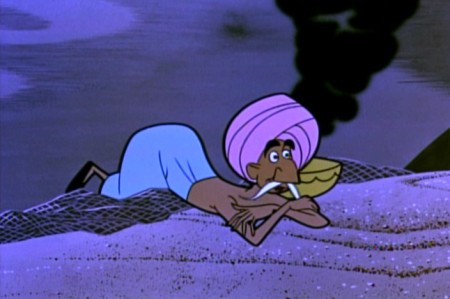 16
16
But the fisherman gets an idea.
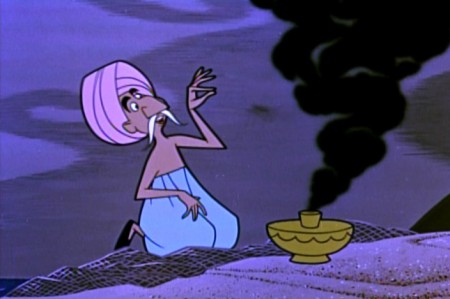 19
19
He says he doesn’t believe that the Genie
could not have fit into so tiny a lamp.
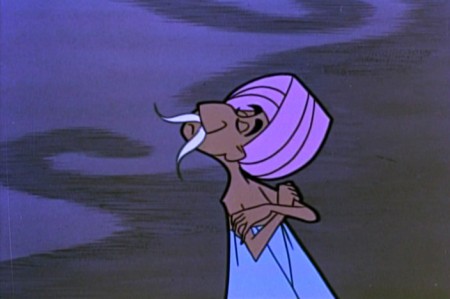 21
21
He challenges the Genie to prove that he can fit into the lamp.
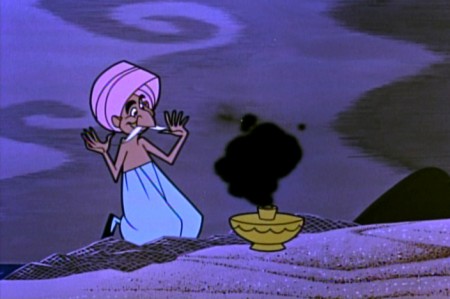 23
23
The Genie goes back in . . .
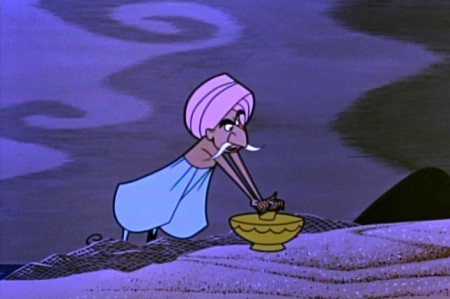 24
24
. . . the fisherman stops him in there.
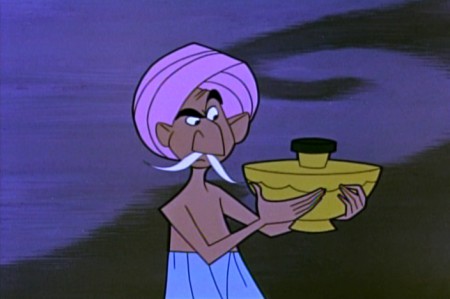 27
27
The Genie makes a magnificent deal
if the fisherman will let him out again.
.
The program then goes into the history of the discovery of radiation and the atom and control of atomic energy.
.
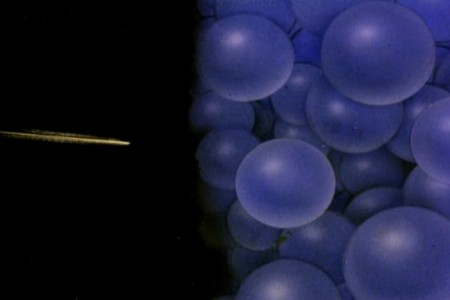 32
32We pick things up with the splitting of the atom.
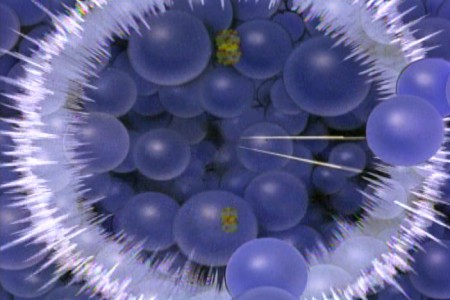 34
34
A chain reaction gets things going.
Disney &Frame Grabs 02 Jan 2012 07:24 am
Ye Olden Days
- Hans Perk has posted the draft for the 1933 Mickey short Ye Olden Days. Since I absolutely love this period of Disney films, I thought I’d combine my frame grabs with some animator IDs. It was fun going through this short.
 Obviously, several animators were just breaking in under the tutelage of Ben Sharpsteen. Consequently, you get some scenes that are double assigned; it means that Sharpsteen is closely watching the new animator. A lot of the scenes that are assigned to Sharpsteen alone, actually are done by others with Sharpsteen supervising. When I know who did what (Hans Perk gives away several), I indicate it under the image.
Obviously, several animators were just breaking in under the tutelage of Ben Sharpsteen. Consequently, you get some scenes that are double assigned; it means that Sharpsteen is closely watching the new animator. A lot of the scenes that are assigned to Sharpsteen alone, actually are done by others with Sharpsteen supervising. When I know who did what (Hans Perk gives away several), I indicate it under the image.
Hans is also missing the first page of the animator drafts, so the first few scenes aren’t assigned below. Obviously Norm Ferguson animates most of the king, so he probably did the one scene in this section.


Sharpsteen/Harry Reeves – - – Norm Ferguson

Norm Ferguson – - – Sharpsteen/Art Babbitt

Sharpsteen/Art Babbitt – - – Sharpsteen/Marvin Woodward

no animator – - – Sharpsteen/Ham Luske

Dick Lundy – - – Sharpsteen/Ed Love

Les Clark – - – Ben Sharpsteen

Dick Lundy – - – Norm Ferguson

Norm Ferguson – - – reuse animation

Norm Ferguson – - – Ben Sharpsteen

Ben Sharpsteen – - – Tom Palmer

Norm Ferguson – - – Tom Palmer

Tom Palmer – - – Norm Ferguson
Daily post &Frame Grabs &repeated posts 26 Dec 2011 06:37 am
Making Snow White
- On the Snow White dvd, there’s a documentary about the history and making of the film. Some of the images on the disc are just too precious for me to allow them to slip by without my singling them out and writing about them.
.
Here are frame grabs from this documentary.
.
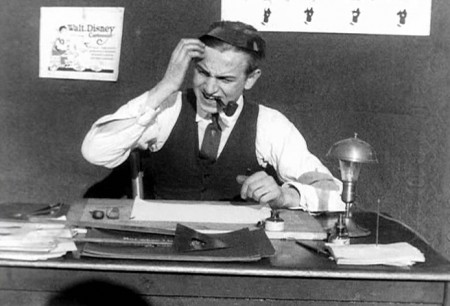
Walt is presented as a bumpkin in the early days.
I suppose he was directing if not filming this material,
so that’s the image he sought to create as well.
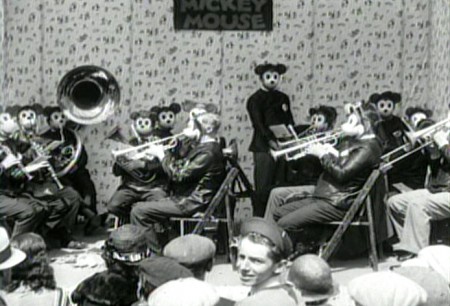
This has got to be one of the wackiest pictures in their archives.
The popularity of Mickey Mouse in the early 30′s.
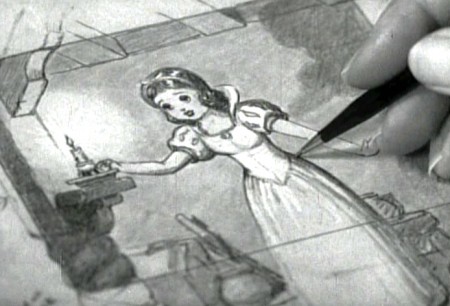
Snow White brings a change to the studio,
which you can well understand.
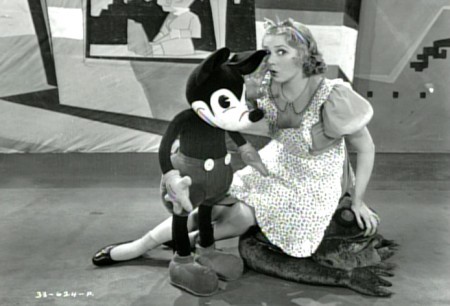
Though there’s still the problem about what to do with Mickey.
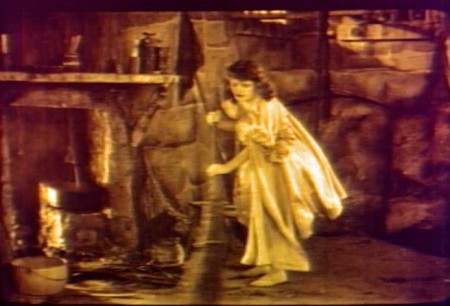
Disney was supposedly inspired by a silent filmed version
of Snow White he saw in his younger days.
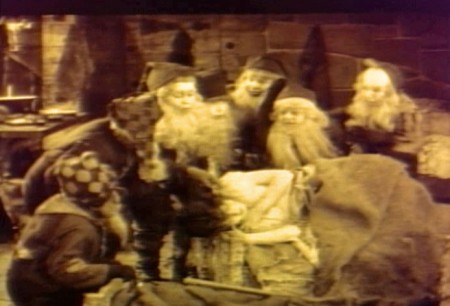
One wonders if there was also an eerie creepiness to the performance
that Walt gave to all of his animators one night as he acted out the film.
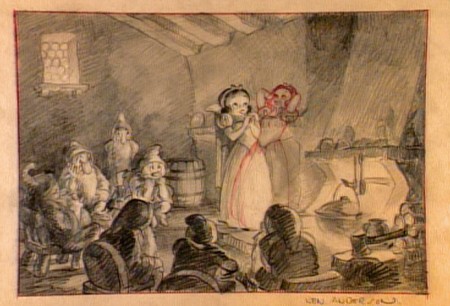
I’m curious about the pose of Snow White with her head back
and her hands behind the head.
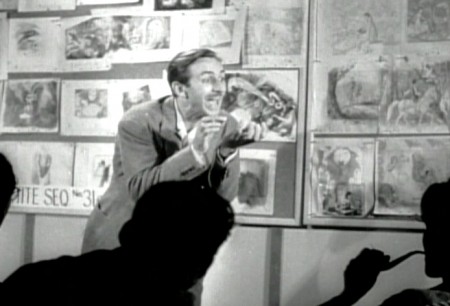
Here, Walt tries to get his animators to bite into an invisible apple -
the future of animation – as they thoughtfully smoke their pipes.
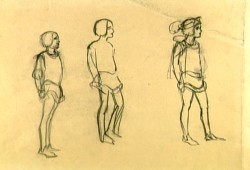
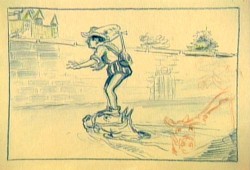
The bed building and the soup eating scenes weren’t the only ones that were
excised from the finished film. It seems the prince, initially had a larger role.
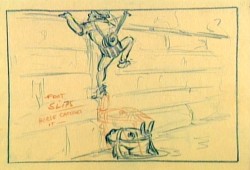
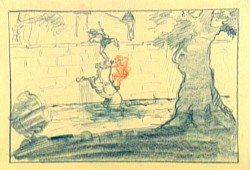
The path into the castle was a bit more difficult. First you had to
get past the moat with the help of your horse. Here the prince looks
a bit like Robert Benchley.
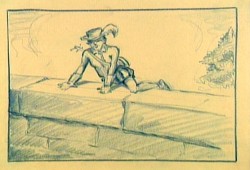
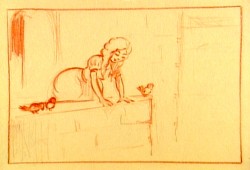
“Romeo, Romeo, Wherefore art thou, Romeo?”
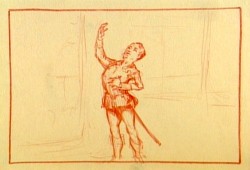
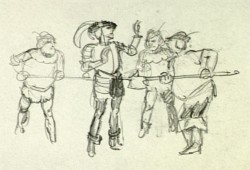
Getting caught. Obviously, the Queen and Snow White didn’t live in that
castle by themselves. There were henchmen we didn’t know about.
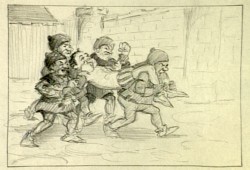
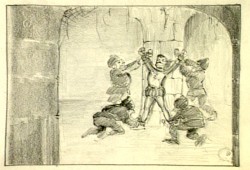
This almost looks like an early version of the seven dwarfs
carried the prince to prison.
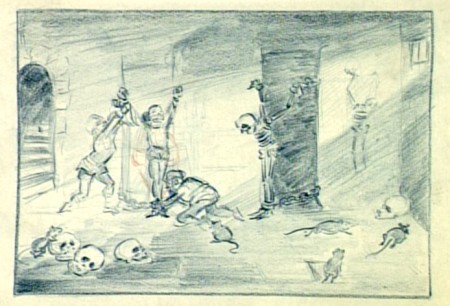
They had big rats in that prison. Scary.
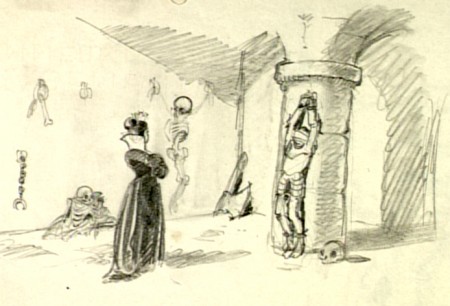
This is an obvious precursor of Malificent going to visit Prince Phillip some
20 years later in Sleeping Beauty. Both wicked Queens got more attractive.
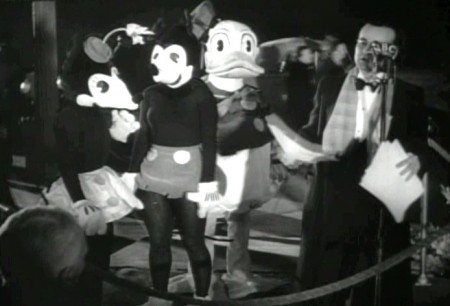
Lots of stars showed up to the grand premiere.
These actors in costume were there, too.
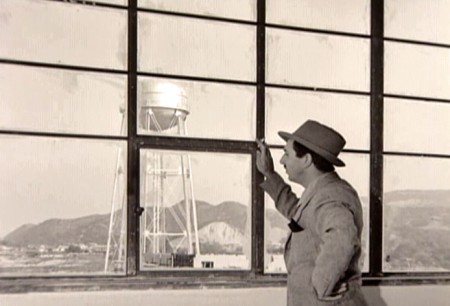
In all seriousness, the film was a masterpiece. I’m still studying it some
74 years later. Walt had reason to be proud and happy. He also had enough
money to move onto other challenging films, and he took the challenge as
opposed to making Snow White 2 or 3 (as they probably would do today.)
Commentary &Frame Grabs 12 Dec 2011 06:03 am
Iwerks’ Sinbad
– When I was young, about 12 years old, I saved my money to buy an 8mm projector. This was long before DVDs, before VHS tapes and before even Super 8mm. The used projector cost me $20. I bought it from a NY store called Peerless Photo Equipment. They also had a large department of home market 8mm shorts that could be bought for relatively little money. Lots of Castle films (meaning Universal short subjects 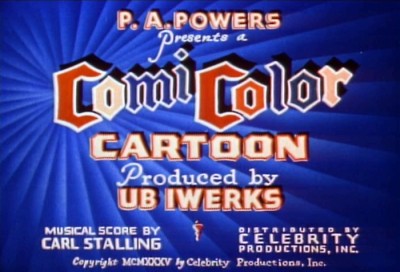 Walter Lantz Woody Woodpecker), a few Disney shorts, a few WB shorts and plenty of Ub Iwerks films. I was an Iwerks fan and my immediate interest was in these films which I had never seen. The same day I bought that projector, I bought a 6 min version of “Jack & the Beanstalk” as well as a 3 min version of “Sinbad the Sailor.” Both were sold only in B&W, and they were silent with a few intertitles. (It’s amazing how well they worked as silents.)
Walter Lantz Woody Woodpecker), a few Disney shorts, a few WB shorts and plenty of Ub Iwerks films. I was an Iwerks fan and my immediate interest was in these films which I had never seen. The same day I bought that projector, I bought a 6 min version of “Jack & the Beanstalk” as well as a 3 min version of “Sinbad the Sailor.” Both were sold only in B&W, and they were silent with a few intertitles. (It’s amazing how well they worked as silents.)
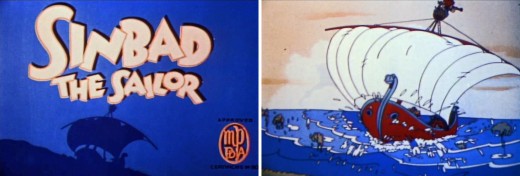
When I finally got to see both films in color it was an amazing surprise for me.
I knew they were in Cinecolor, and I expected much worse than what I got.
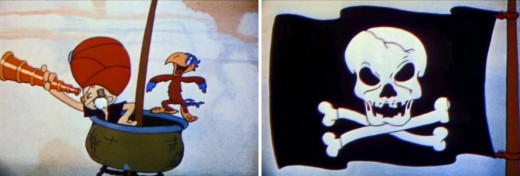
With Sinbad, I was surprised at how little I remembered of that film.
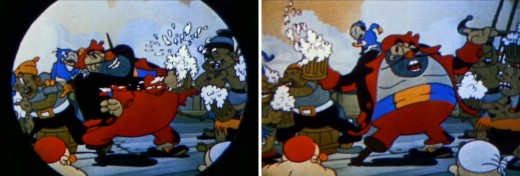
I remembered almost nothing about the pirates. I didn’t forget
Sinbad in the crow’s nest with his parrot espying on the other ship.
I particularly remembered the big bird at the end of the film.
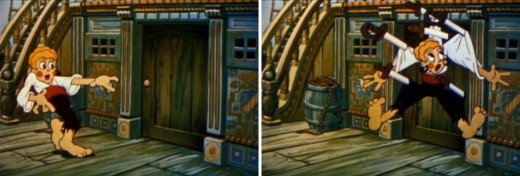
The shortened version did not include this anti-gay joke in it.
Watching it for the first time, I wondered how many other such
jokes were in the films. There were plenty of racist jokes
(including the one I eliminated at the very end of this film.)
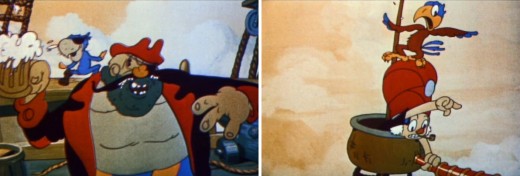
It’s amazing how much those early short films stayed with me over the years,
however this one has just left an impression without my remembering much of
the details of the story.
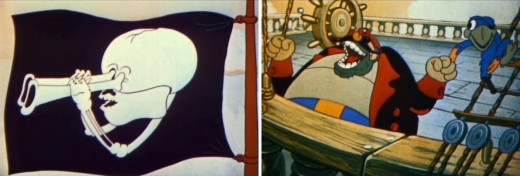
After all, I studied every frame of these films. I’d figured out how to
jerry-rig my 8mm projector to allow me to do that. I could watch each
film one frame at a time.
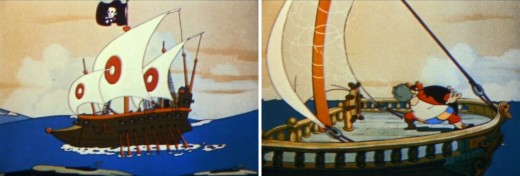
I remember when I first met Grim Natwick that I told him his was the
first animation I ever studied. “Jack & The Beanstalk” left an impression.
Grim wasn’t impressed when I told him.
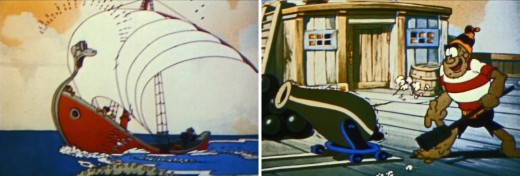
The most I could learn about the crew of this film is that Grim Natwick
(who probably directed) animated along with Stephen Bosustow.
I believe Pete Burness was also with the studio at this time. Berny Wolf
was there at this time and may have animated on Sinbad.
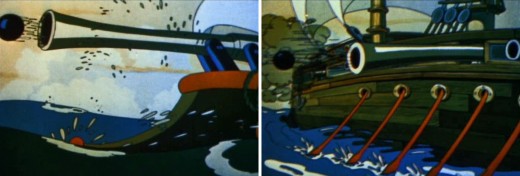
I soon had bought a complete library of animated shorts.
Both “Jack & The Beanstalk” and Woody Woodpecker in
“Ace In The Hole” were favorites of mine back then.
Grim Natwick and Alex Lovy.

I also bought a couple of WB shorts. I particularly liked the
Chuck Jones directed films. I’d seen “Hair Raising Hare” and
“Rabbit Punch” so many times in the 8mm versions that
it’s almost hard to watch them again.
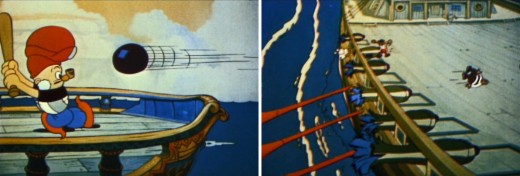
The WB cartoons handled the titles well. They did them
as subtitles, and I liked buying these films for this reason.
Of course, it was a plus that they were such good films.
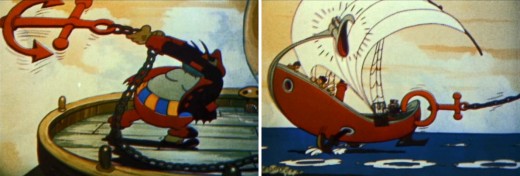
I’m surprised that the Iwerks staff took no attempt to adapt the actual story
of Sinbad from the Arabian Nights, but instead they completely created their own.
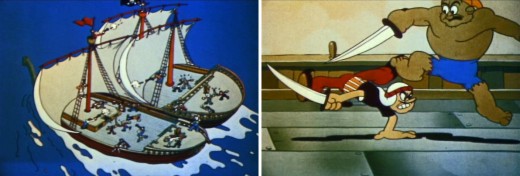
Ted Sears and Otto Englander, were both doing story work for Iwerks,
so they probably had a hand in shaping this film. Eventually, both men
would move on to Disney’s studio where they did exceptional work.
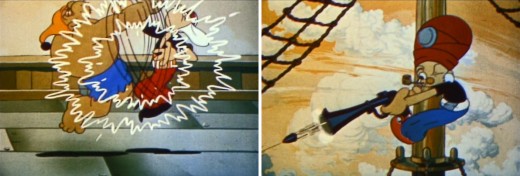
By the time this film was made, Iwerks, himself, had lost interest
in the actual production of the shorts, and he’d tried to get Grim Natwick
to take a piece of the studio to run the production.
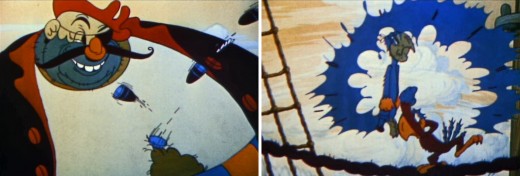
Natwick had refused knowing full well how difficult it was to
manage a studio and try to stay afloat. Especially knowing,
as I’m sure he did, that the studio was in trouble.
He rejected the offer.
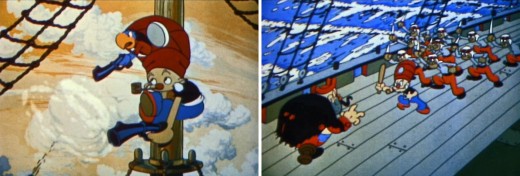
In fact, within a year Natwick, Shamus Culhane and others had
migrated to the Disney studio. Culhane had a side-step going back
to NY to work under Bert Gillette for Van Buren. When that ended
badly, Culhane went to Disney to work for less than he made in NY.
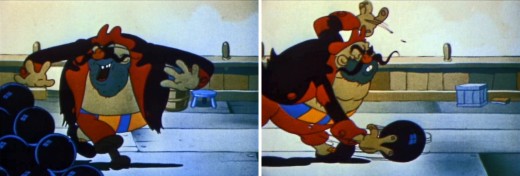
Berny Wolf, Al Eugster and Steve Bosustow also moved to Disney’s.
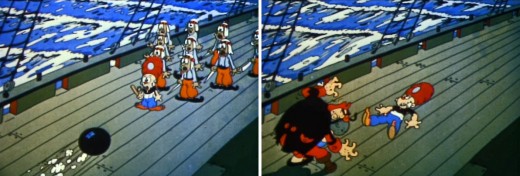
The bowling pin joke has got to be one of the older jokes used in animated films.
I’m sure the addition of sound helped sell the gag during the early sound years.
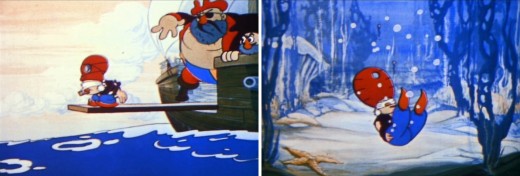
Others at the studio such as Chuck Jones and Frank Tashlin
as well as Bugs Hardaway and composer, Carl Stalling,
moved over to Schlesinger’s studio at Warner Brothers.
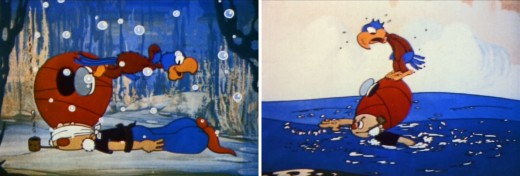
“Sinbad” was part of a trilogy of films Iwerks made from the
Arabian Nights. There was also “Aladdin” and “Ali Baba.”
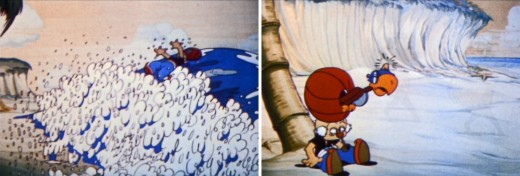
All three were really just titles to hang a cartoon on.
These were part of the attempt to try to gain a bit of success
after Willie Whopper and Flip the Frog had both failed as series.
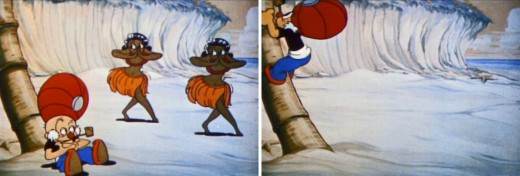
There’s no doubt that Grim Natwick did these dancing girls.
It was his signature style at the time.
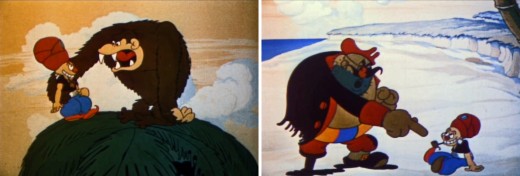
Iwerks was moving his studio to the edge of the precipice.
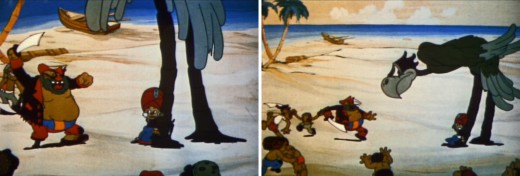
Iwerks introduced his version of the multiplane camera about
this time, trying to offer something new to the medium.
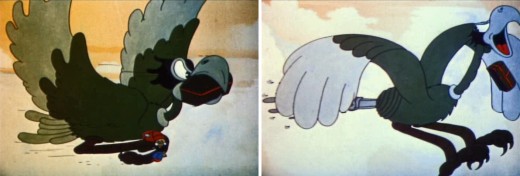
The Headless Horseman and The Valiant Tailor both showcased
the multiplane camera in its production. Neither took off.
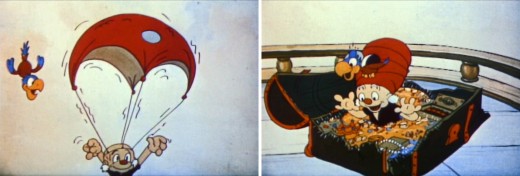
It wasn’t much longer before the Iwerks studio
floundered and ultimately died off.
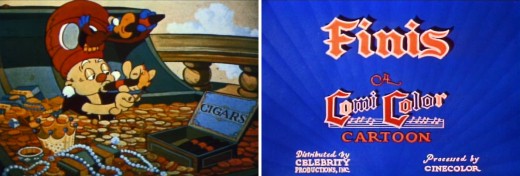
The final joke (cut out) shows the cigar exploding leaving
Sinbad with a black face with just a touch of racist humor.
________________________
.
Here’s the YouTube version of this short.
Frame Grabs &Independent Animation 07 Nov 2011 07:46 am
The Hill Farm – 2
- Last week I began posting frame grabs from one of my favorite short films, The Hill Farm; it was released in 1989. The film was the first significant work of a new film maker, Mark Baker. Baker went on to form a commercial production studio in London, Astley Baker Davies, Ltd. This company produced several recent television series: Peppa Pig, Ben & Holly’s Little Kingdom, The Big Knights.
Baker did two other significant short films: The Village and Jolly Roger. All three of his shorts, including The Hill Farm were nominated for Oscars. All three of them should have won the award, except that they were up against Aardman.
Here is the conclusion of the frame grab selection from The Hill Farm:
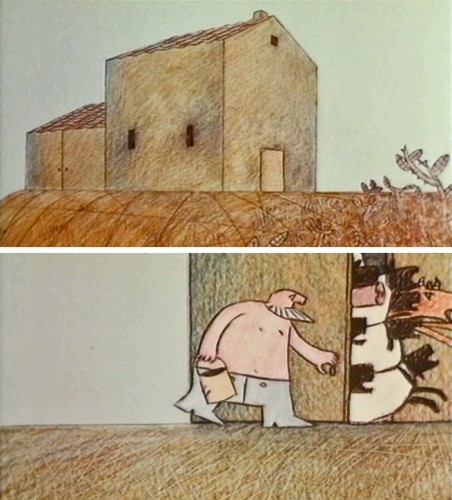 2
2
